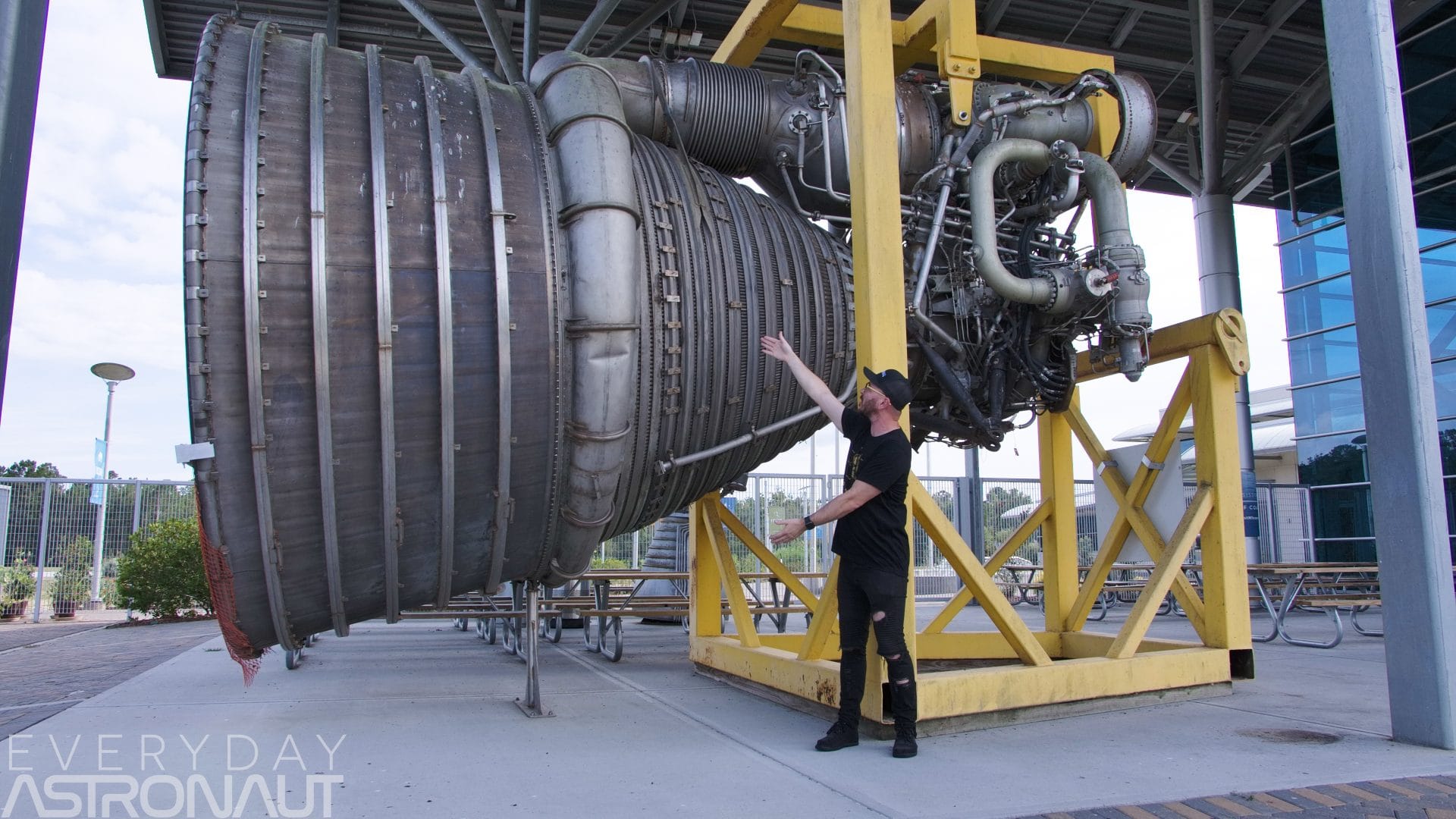
This is a rocket engine. Really, all it is is a heat and pressure machine whose end goal is to convert that heat and pressure into workable thrust. The more that gets converted the better. This conversion is usually done by a large bell nozzle. That’s the job of every single centimeter of this giant nozzle. The further down the nozzle you go, the lower the pressure and temperature of the exhaust gets and the more it’s exchanged for higher and higher exhaust velocities. So in general, you want this nozzle to be as big as possible in order for it to convert as much of that energy as possible.
Only one problem. When the exhaust pressure at the end of the nozzle gets below the pressure of the outside ambient air surrounding, the ambient air actually starts to squeeze in on the exhaust gas. Lower the pressure too much and the ambient air will squeeze in on the exhaust so much that it will actually start to peel the exhaust off the nozzle walls and form random shock waves and spikes that will tear apart the engine. So what if you turned an engine inside out and made it so the ambient air pressure is actually pushing the exhaust IN against the nozzle instead of squeezing the exhaust away from the nozzle.
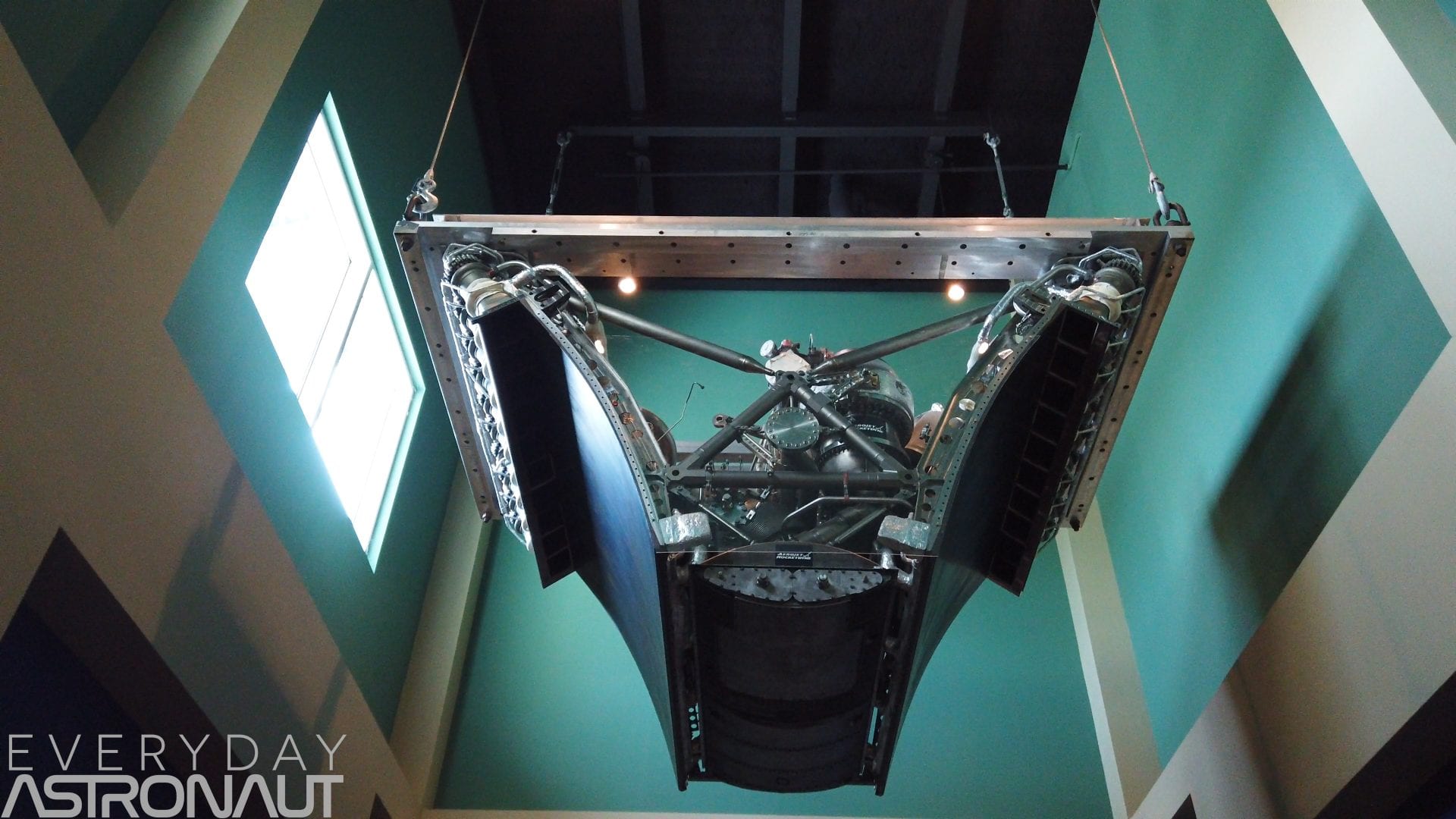
Well that’s the theory behind the aerospike engine. Not only do they do exactly this, they also promise to increase engine efficiency throughout ascent because that inside out nozzle inherently forms a nearly perfect shape for the exhaust to follow at any altitude, increasing their efficiency at all altitudes. And with engineers relentlessly trying to optimize rockets in a world where even a 1% improvement is a massive leap, the aerospike engine seems like a dream come true!
Throughout history, there have been a number of aerospikes that have made it really far in development, but to date, none have ever really flown, let alone been used on an orbital class rocket… If they’re so good, shouldn’t everyone be using them, or for that matter, shouldn’t ANYONE be using them? Why aren’t new generation engines that are built from the ground up like SpaceX’s Raptor engine, aerospikes?

So today we’re going to look at the history of aerospike engines, go over how nozzles work including things like over expansion, under expansion, and even expansion ratios, we’ll look at the pros and cons of the aerospike, the physical limitations, and problems, then we’ll compare the aerospike to some other traditional rocket engines.
But that’s not all, I obtained never seen before photos and videos of some aerospikes, we’ll get opinions from some people who have actually worked with aerospike engines, look at some promising prospects and compelling concepts and by the end of the video we’ll hopefully know whether or not the holy grail of rocket engines is just waiting to be utilized or if aerospikes just simply aren’t worth it.
Put on your favorite aerospike engine shirt, grab some popcorn a drink and maybe a notepad, cuz this one’s a long one and we have a LOT to cover… Let’s get started!
Those of you that follow me on Twitter have probably been watching this article come together and likely have noticed my tone on this subject has changed from “aerospikes SUCK” to a more neutral stance on the subject… And wow, after months of research, this article turned out to be a monster. I mean, we ended up going through literally dozens and dozens of hard to find documents to track down the numbers for aerospike engines from their source.
And although it took a while (sorry), the more I learned the more I realized I how much more I needed to learn and the more context I knew would need to be put into this article to make it understandable…
After I posted my “Is SpaceX’s Raptor engine the king of rocket engines” and “Why SSTOs suck” articles, I got so many people claiming that the real holy grail of rockets is actually the aerospike… And you’re not wrong. I mean, an engine that magically (thanks to physics) is inherently more efficient at almost any altitude? An engine that works as well at sea level as a perfectly tuned sea level engine bell and still performs just as well in a vacuum as a large vacuum bell? Wow, YES sign me up!
Why isn’t there more love for aerospikes in the aerospace industry? I mean, after all, SpaceX engineers tackled the ultimate challenge by developing a methane-powered full-flow staged combustion cycle engine… If you can solve that crazy engine, why didn’t they try for an aerospike, something that promises some pretty substantial gains AND they’ve already been fully developed.
After all, aerospikes definitely aren’t new. They actually go back to the 60’s when engineers were looking for ways to improve upon some early rocket engines. Keep in mind, the engines at this point in time were relatively primitive, so the promise of an aerospike engine was extra appealing.

Maybe the most notable and promising aerospike was an aerospike version of the J-2 engine that powered the second and third stage of the Saturn V. This was called the J-2T and on paper it seemed to be a nice and compact version of the J-2 while offering even greater vacuum efficiency than the standard J-2. Although it hit the test stand 34 times and had some promising potential, it was shelved alongside the Saturn V and any potential upgrade path thereof once the Space Shuttle program began. BUT it was actually considered for use as the space shuttle main engine, but as we know, NASA went with a closed cycle bell nozzled engine, the RS-25.

Rocketdyne also took spare parts from the J-2 and the simplified J-2s rocket engines and developed a linear aerospike engine known as the L-1 linear test bed from 1970 to 1972 and had 44 tests with 3,113 seconds of operation.
It would be almost 30 years before the concept would be dusted off again and looked at with any serious consideration, and this time it was for a space shuttle replacement known as Venture Star. The Venture Star was a rocket nerds ultimate dream rocket, a single stage to orbit or SSTO, fully reusable space plane that was to utilize linear aerospike engines called the RS-2200, that not only made it look like the millenium Falcon, but it also promised nearly the same payload capability to low earth orbit as the space shuttle it was intended to replace.

In order to minimize risk, Lockheed Martin began the development of a suborbital demonstration version of the Venturestar called the X-33 which was to use a smaller testbed version of the RS-2200 called the xRS-2200. It was fully operational and had accumulated 17 tests and about 1,600 seconds of test stand operation.
But because of the overly ambitious use of super-advanced carbon composite tanks, a few other technologies that had yet to be perfected, and some interesting politics, Lockheed Martin may have bitten off more than they could chew. The Venturestar program and the X-33 along with the RS-2200 and xRS-2200 linear aerospike engines were put on the shelf in 2001.
Ok, so what the heck. Is the aerospike just a bad luck engine? Being assigned only to programs that are destined to be cancelled? Why aren’t any of these plans being resurrected now with more modern technologies? Well let’s first get into how they work, and in order to do so, we should do a quick overview of how and why a traditional bell nozzle works so we know how to compare them against aerospikes. After all, the physics are the same between aerospikes and bell nozzles… so let’s dive in.
How Nozzles Work
Rockets work by taking a high pressure gas with molecules traveling in all directions and turning that pressure into a high velocity flow in a very specific direction, and if all things are going smoothly, the direction of the flow is exactly opposite of the direction the rocket is pointing…
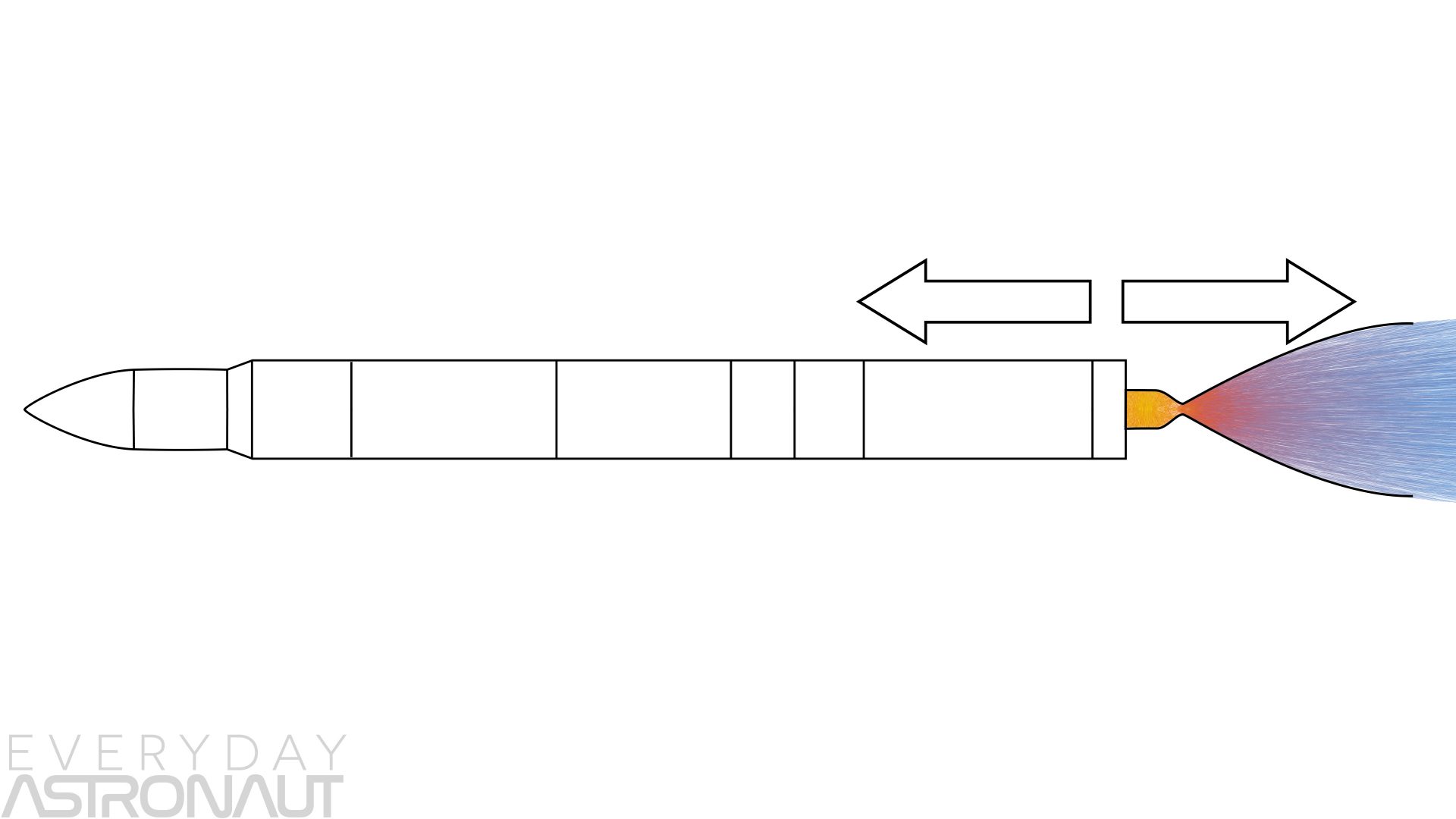
As we talked about in my video about the Raptor engine, the chamber pressure in rocket engines can be unbelievably high. SpaceX’s Raptor engine is currently the king of chamber pressure at 270 bar and they’re aiming for 300 bar. Just to put into perspective how much pressure that is, that’s like putting a BMW 740i Sedan which weighs nearly 2 tonnes and placing it on something not much bigger than an average sized US Postage stamp!
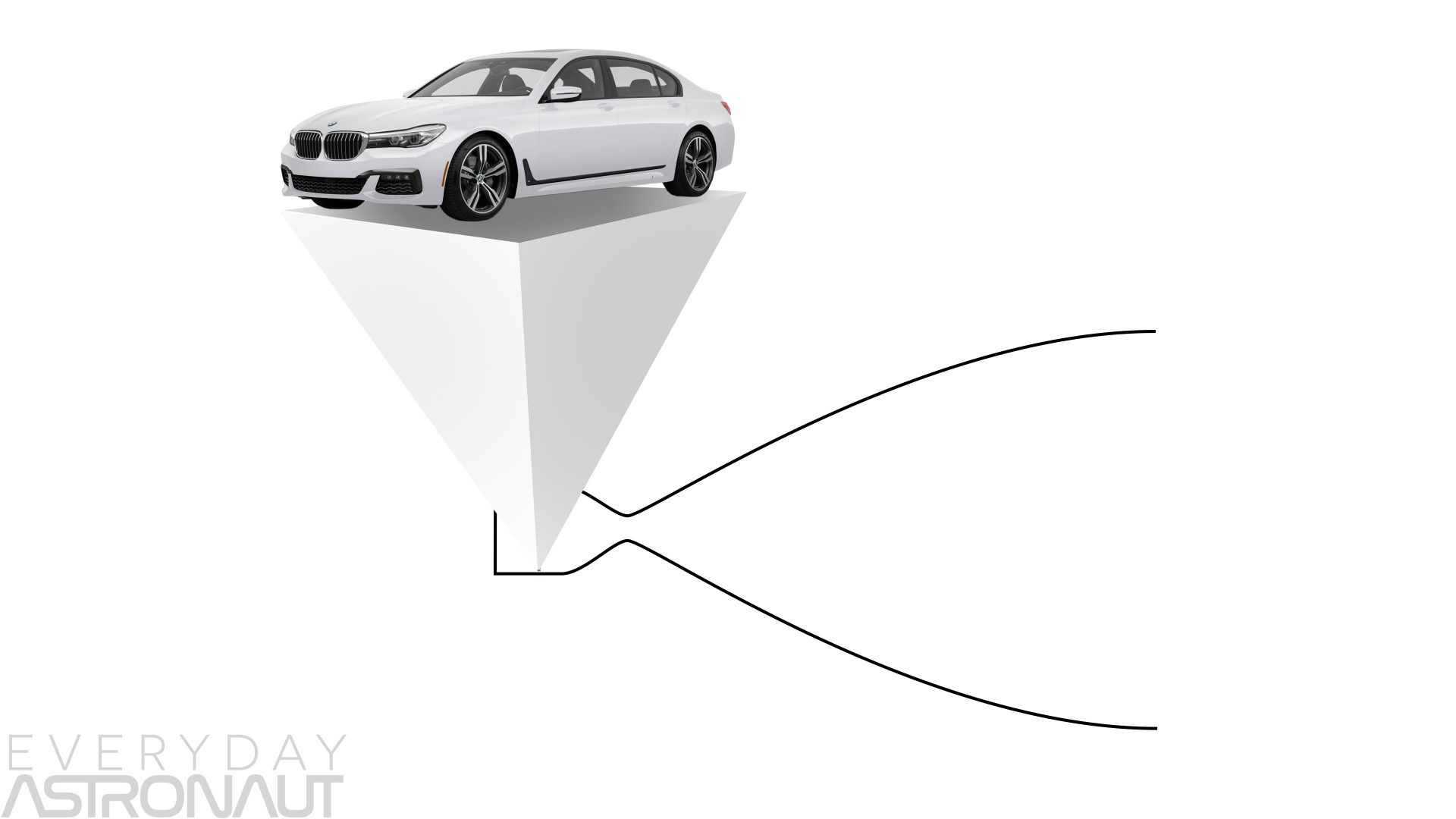
That’s how much pressure is pushing on every single square inch of the combustion chamber. To convert that pressure, engineers developed something called a converging-diverging nozzle, or a de Laval nozzle, that converts those high-pressure gas molecules traveling in all directions to a high-velocity gas moving in one direction.
Now we’re about to go to fluid dynamic city here real quick, and not just any old fluid dynamics but super nutty stuff where everything gets backwards and upside down as we’re going to transition from a subsonic high pressure hot gas into a supersonic low pressure cooler gas. So if our combustion chamber was just a tube coming off the injector, we’d end up with some hot gas moving out pretty fast, but not supersonic. And fun reminder here about rocket engines and rocket engine efficiency, the faster the exhaust gas is ejected, the better.
In order to accelerate a gas moving through a tube, we can actually shrink the size of the tube. The same amount of mass will pass through this smaller area, and in order to do so, it needs to speed up.

I think the best example of this is a standard old garden hose. Turn it on and put your thumb over the end of the hose. Ignoring a few potential loses, the same amount of water will flow through the hose regardless if your thumb is covering the end or not. The only thing that changes is the water has to speed up to move the same volume of water through a smaller hole. Remove your thumb and the water slows down, but both methods would fill up a bucket in the same amount of time. One will just be a lot more splashy than the other.
So the same thing applies to pass gas through a tube. We can keep shrinking the tube until we get to the point where the gas is traveling at sonic speeds, or at the local speed of sound. I say the local speed of sound because the speed of sound goes up with the square root of temperature and because the temperature in rocket engines is REALLY high, the speed of sound at the throat can be 5 to 10 times that of room temperature at sea level!
Once the exhaust gas is traveling at the speed of sound, we can’t actually shrink the tube anymore because here’s where things get quite literally backwards. Once gas is traveling at the speed of sound, if you shrink the tube anymore, you simply end up choking it. So from this point on, engineers design the nozzle to be a perfect shape which will convert thermal energy into kinetic energy. As the walls of the nozzle get wider, it actually accelerates the gas, and the pressure and temperature lowers.
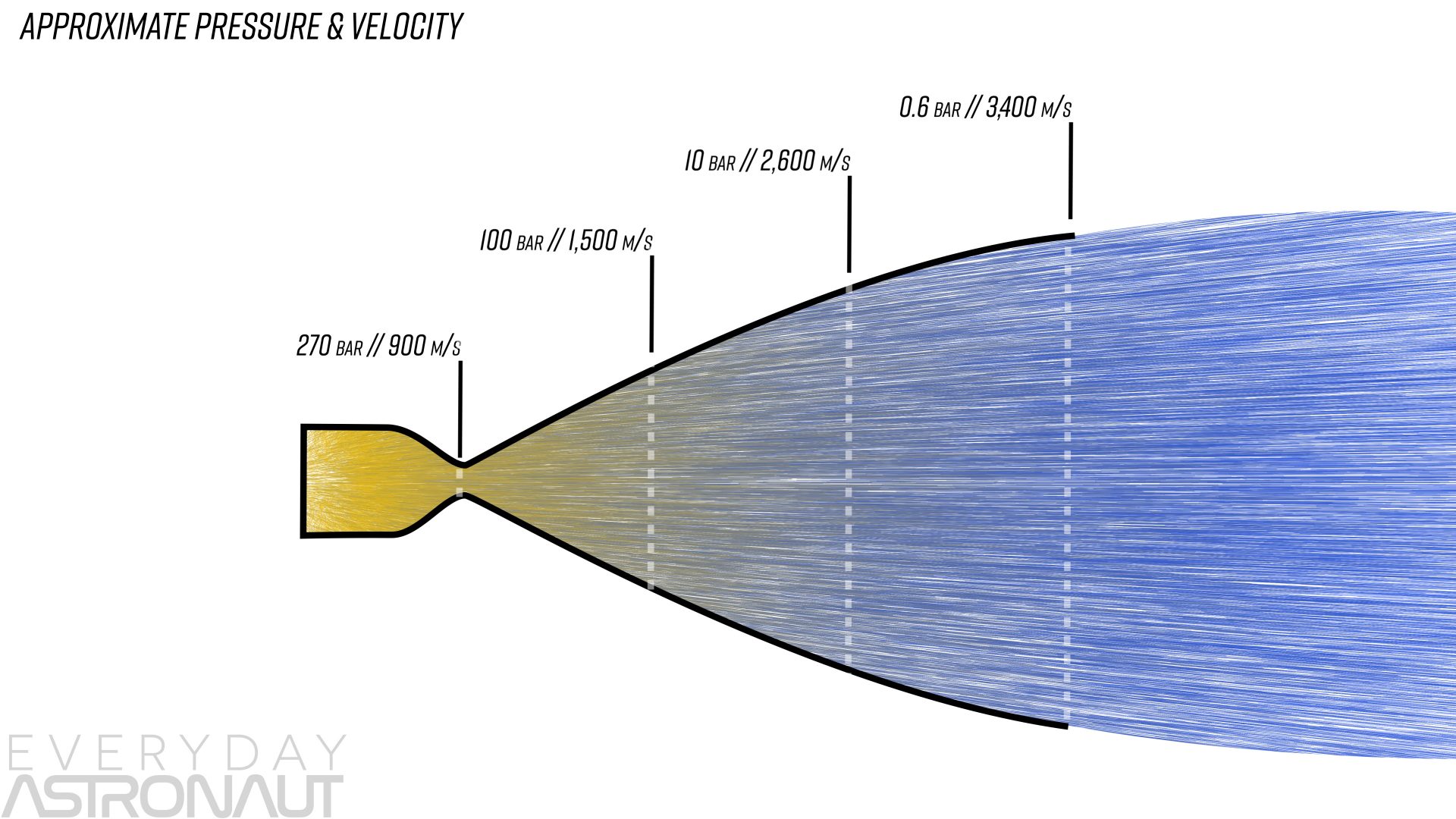
If you make the nozzle big enough, you’ll get to the point where the exhaust is actually at the same pressure as the ambient air outside, or in the case of sea level, 1 bar of pressure. It’s actually amazing to me we can go all the way from hundreds of bar of pressure down to less than 1 bar in such a relatively short distance. And it’s also weird that even though the gas is moving at unbelievable speeds, the exhaust pressure can actually get really low. And the lower pressure we can get the exhaust gas, the more we’ll have converted high pressure into high gas velocity, which is desirable.
But as a rocket climbs in altitude, the ambient air pressure outside of the rocket lowers… so the pressure at the end of the nozzle becomes higher and higher than ambient pressure. You can see their plumes expanding out in all directions once the rocket is in the vacuum of space. This is why vacuum optimized nozzles are so freaking big. The perfect example of this is SpaceX’s Merlin engine which has the same combustion chamber between the sea level version and the vacuum version.
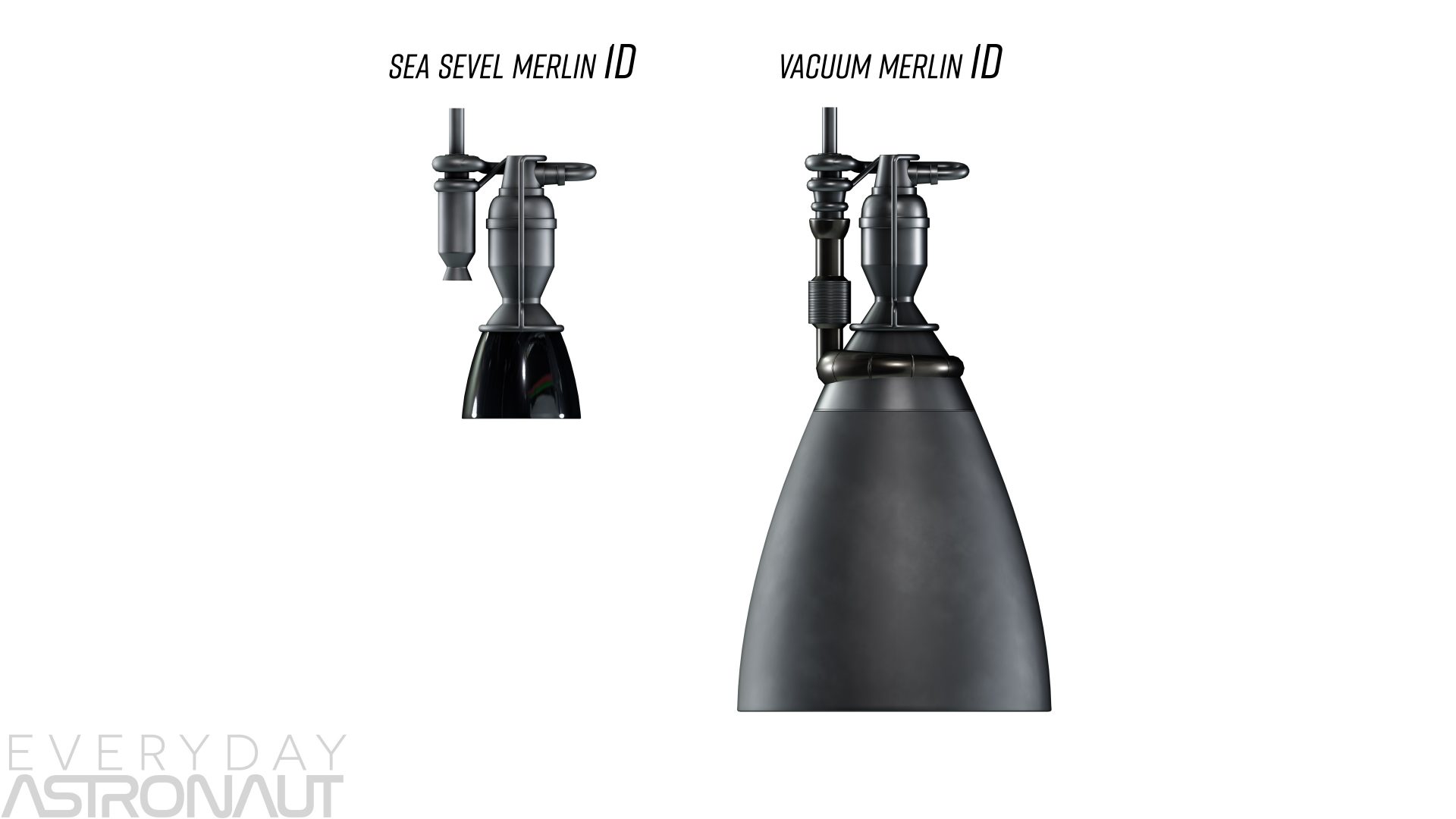
The sea level version with its sea level nozzle is small enough that SpaceX can fit 9 of them around the 3.7 meter wide Falcon 9. But the upper stage vacuum engine has only one engine because the vacuum nozzle’s bell is about 3 meters wide! Just look at how snuggly it fits inside the interstage of the Falcon 9. You can tell whether or not the nozzle is optimal for the altitude it’s at by looking at the exhaust coming out of the nozzle. A nozzle that’s perfectly matching the atmosphere will have exhaust shooting straight out in a perfectly expanded plume.

If the nozzle is too small for the altitude, it’s called being under-expanded and you can see the exhaust immediately getting wider as soon as it exits the nozzle. If the exhaust is traveling out away from the rocket at all, that’s energy literally being spent thrown out the sides. You want the exhaust traveling as straight as possible. Again, you can easily see this with first stages of rockets, as the rocket climbs in altitude, it’s engine’s exhaust plume gets wider and wider.
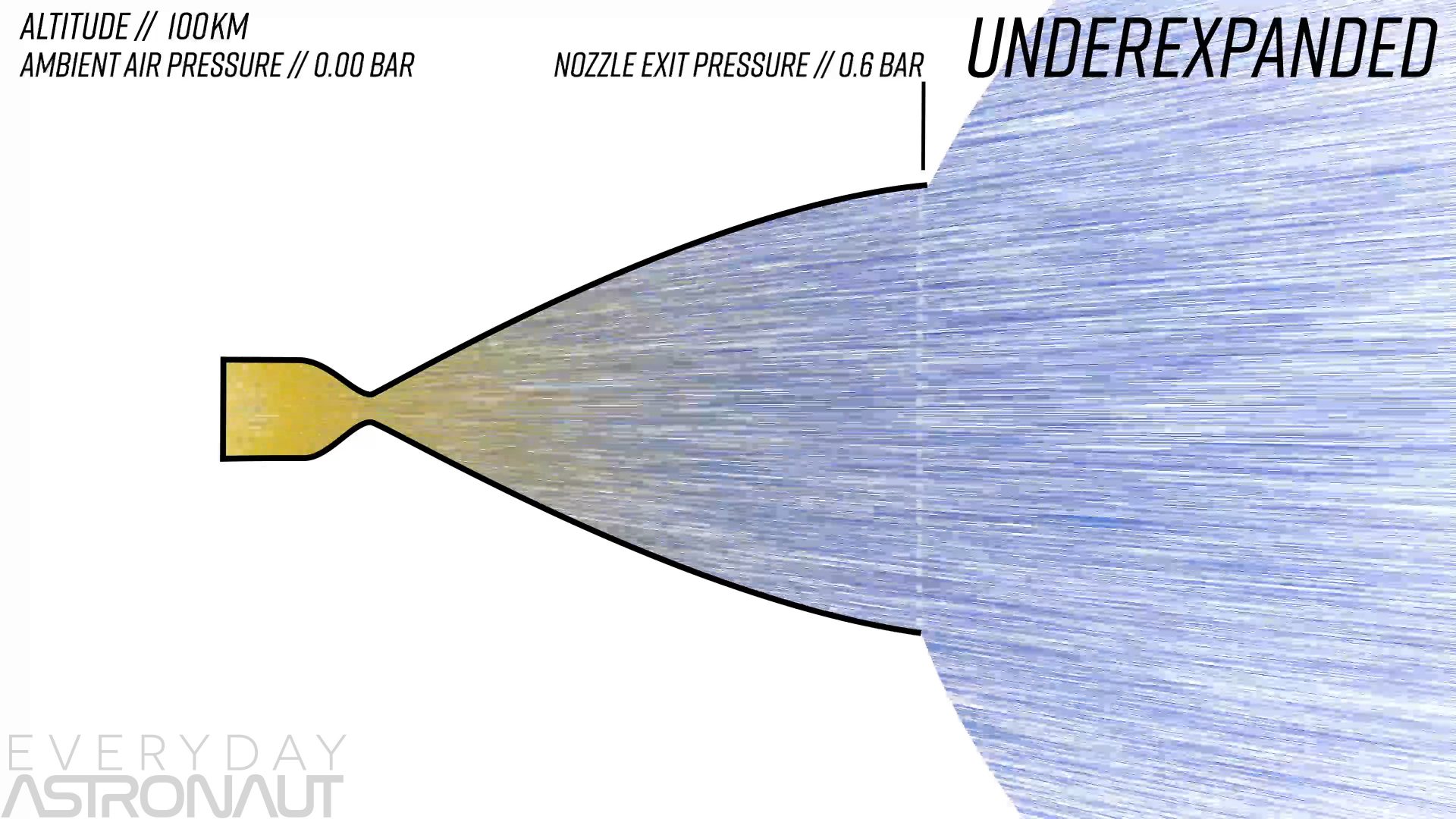
At sea level, nozzles are virtually always too big and that’s called being over expanded. You can tell when a rocket’s nozzle is overexpanded because the exhaust gets squeezed tighter by the ambient air as it exits the nozzle and will even form shock waves known as mach diamonds as the pressure grows and then expands. So you might think, why don’t they just use vacuum optimized nozzles at sea level since rockets only spend their first few seconds at sea level, ambient air pressure drops in HALF by only about 5,000 meters, and they spend most of their time in the vacuum of space?
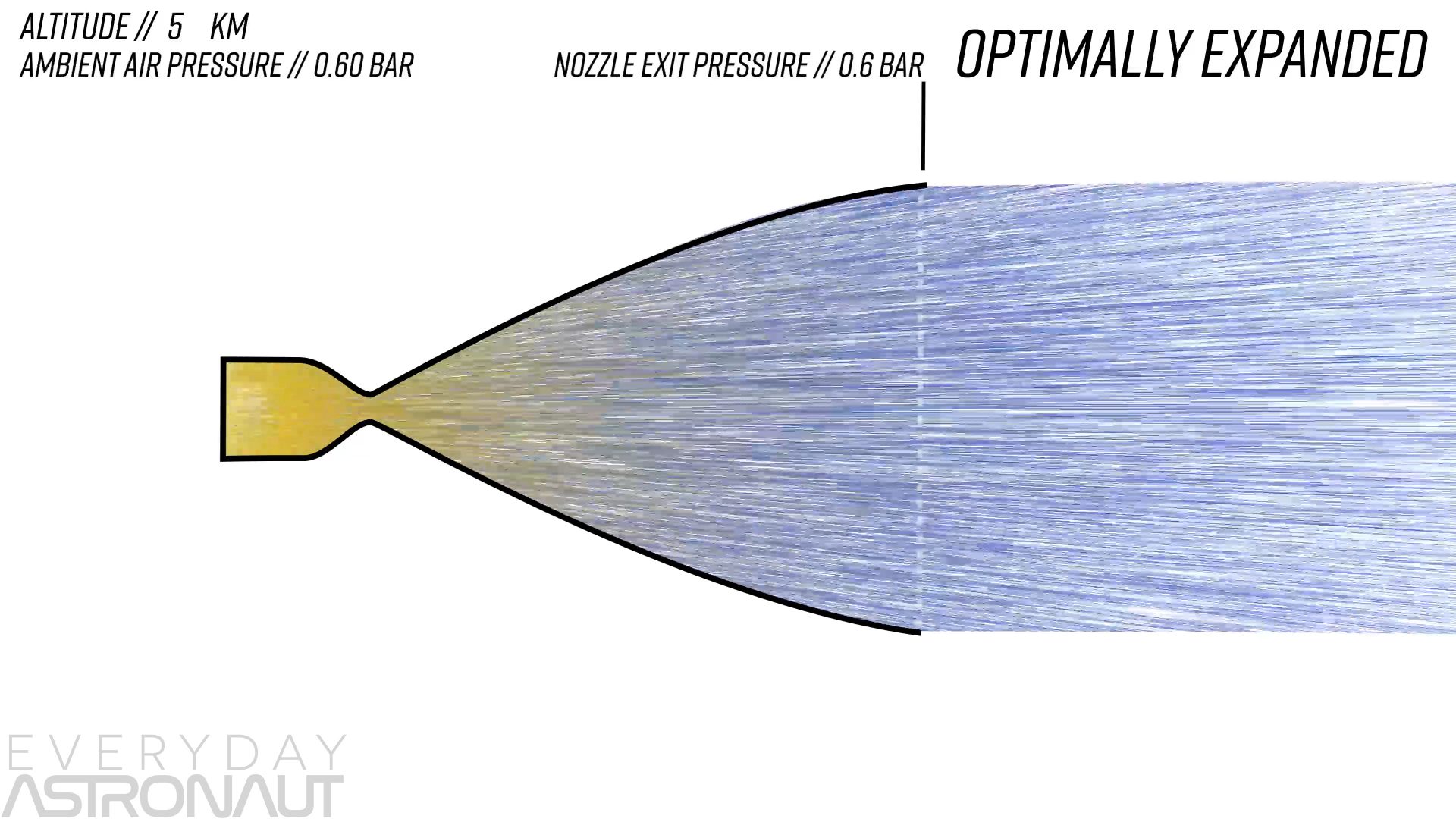
But remember, the further away the nozzle exit pressure is from ambient pressure, the less efficient it is. So a sea level engine in a vacuum is inefficient and a vacuum engine at sea level is inefficient, but there’s actually another, even bigger reason why you usually can’t use a vacuum engine at sea level, because the nozzle would likely break due to something called flow separation.
This is where the ambient air squeezes in against the flow of the exhaust and it actually climbs up into the nozzle, and it does that so much that it can create shock waves and sudden pressure spikes called flow separation which will most likely damage the nozzle. A nozzle can really only go down to about 40% overexpanded before you get flow separation.

Well, that is unless you look at the Space Shuttle Main Engines, the RS-25 which used a unique trick to curl the nozzle walls in ever so slightly which allowed them to get down to about 14% overexpanded without flow separation. This made them more efficient throughout the entire 8 and a half minute ascent since they fired from sea level and stayed running all the way into orbit. And considering how little amount of time is spent at sea level, maximizing nozzle design for the vacuum of space was definitely a good thing.
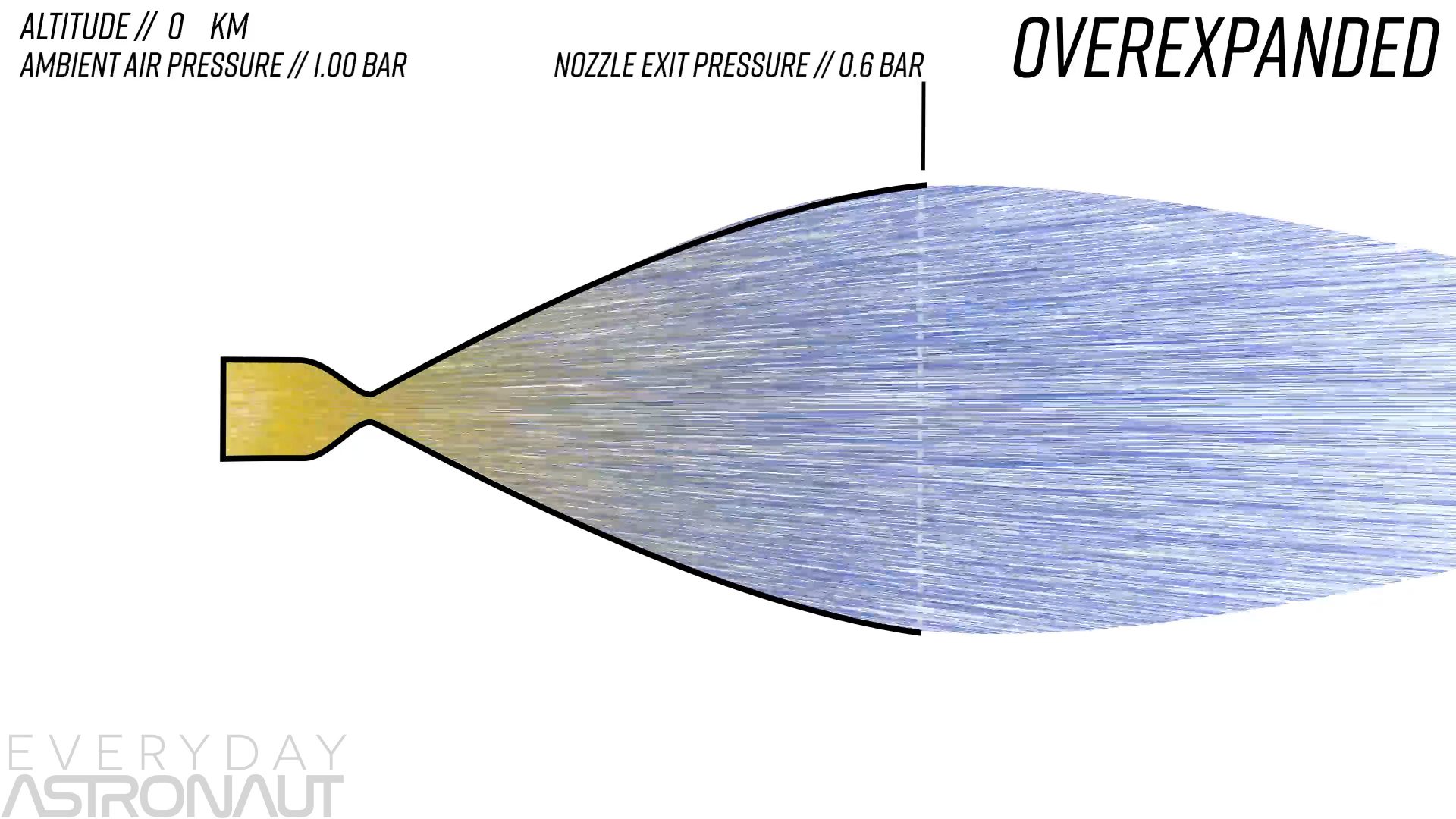
But it is still just weird to think that just regular old air at sea level can be higher pressure and actually squeeze in on rocket exhaust. But the pressure at the tip of the nozzle is actually pretty low, it’s just moving very very fast.
But even if you have a huge vacuum nozzle like the vacuum Merlin 1D, it’s still too small for the vacuum of space. If it were to match the ambient vacuum pressure, the nozzle would need to be infinitely long… and since that doesn’t sound like it’d be very lightweight or fit inside our universe, engineers find the happy medium between packaging, mass, and performance.
The term for how big the throat of the combustion chamber is compared to the exit of the bell is known as the expansion ratio. This is the ratio between the area of the throat vs the area of the nozzle exit.
Again, for ease of reference, let’s look at SpaceX’s Merlin engine which has the same chamber and throat diameter, but with different bells. A sea level merlin has a nozzle that’s 0.91 meters wide (36 inches) whereas the Merlin Vacuum engine has a 2.89 meter wide (114”) nozzle. Since both engines have the same throat of 226mm (8.9”), this means the sea level Merlin has an expansion ratio of 16:1 while the Merlin Vacuum engine has an expansion ratio of 164:1.

I think we tend to look at a rocket engine’s nozzle and go “look at that HUGE ROCKET ENGINE”… when really, we’re seeing the most insignificant piece of the engine. As a matter of fact, many rockets we see on display are missing the actual engines or turbopumps and just have dummy mock up nozzles. So when you hear someone say, “check out these huge engines” you can push your glasses up on your nose and say “the final size of the nozzle has only to do with the expansion ratio of the engine and it does not necessarily correspond to the output of the engine”
It’s kind of like pointing to the wheels of a car and saying “Look at that engine!” Because just like how the wheels of a car transmit the energy of the engine to the road, the nozzle converts the energy of the rocket engine into the workable thrust.
How Aerospikes work
Ok, so you can’t really fire a vacuum optimized engine at sea level… and this, really, is where aerospikes come in. The idea behind aerospikes is you allow the ambient air pressure to actually form the walls containing the flow of the exhaust so it’s always in nearly ideal conditions at any altitude. And not only will you not destroy your engine by lighting it at sea level, it’ll actually perform pretty darn well!
And again, I know it doesn’t seem like it, because it’s what we’re used to, but at sea level, there’s actually an awful lot of air around us. And you don’t really realize how much force it exerts until you remove air from something and see how much force the atmosphere can actually apply.
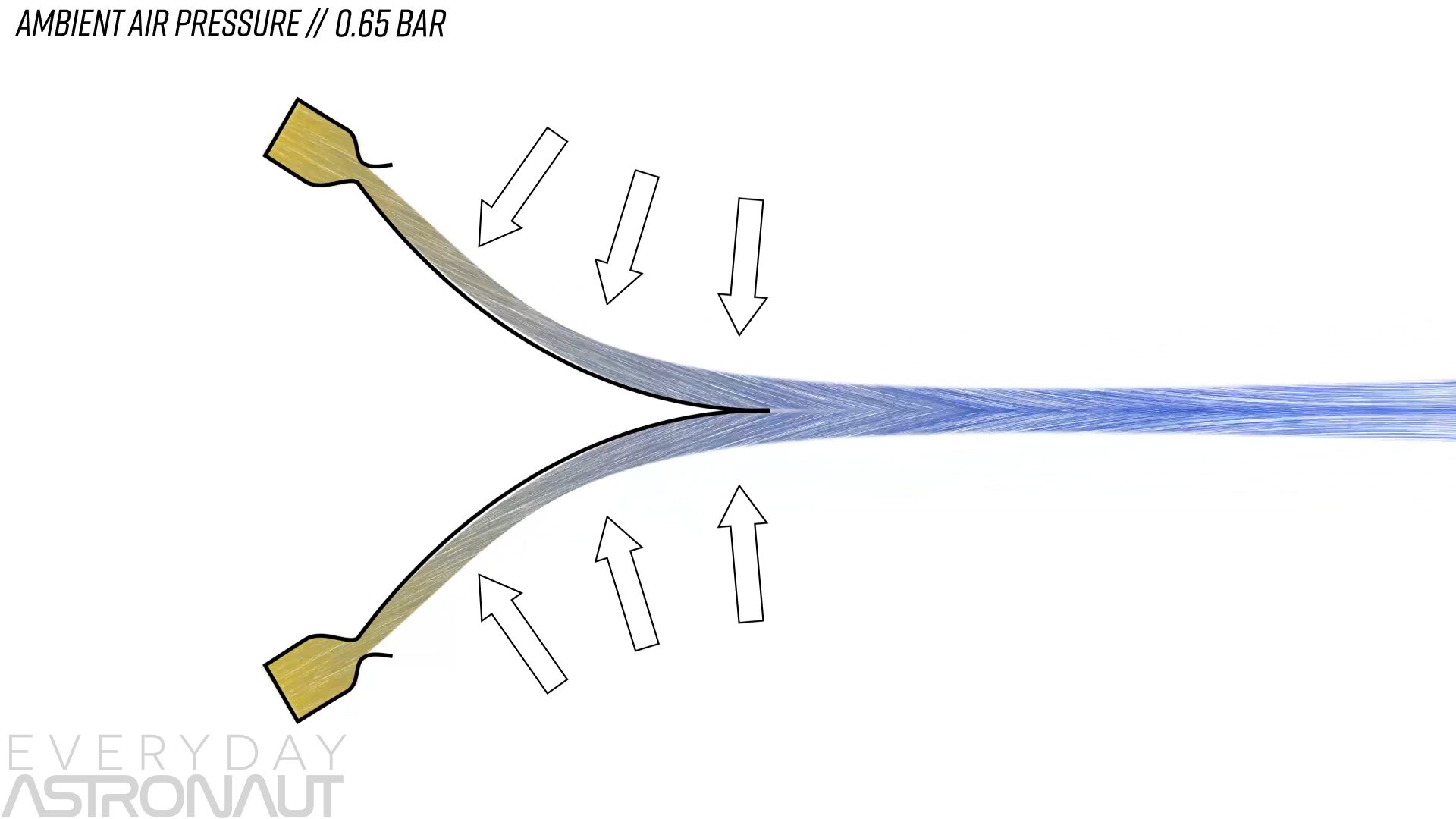
So with an aerospike, the throat of the combustion chamber or chambers aims the exhaust gas at what is essentially just a slice of a traditional bell. When the engine is at sea level, the higher pressure ambient air pushes the lower pressure exhaust against the wall. Instead of the ambient air pressure squeezing IN on the exhaust and pushing it away from the nozzle wall, the ambient air pushes the exhaust further into the nozzle wall, which makes flow separation physically impossible.
As the vehicle climbs in altitude, the ambient pressure decreases and so does the pressure on the exhaust flow. This essentially makes the wall that holds the exhaust grow, changing its expansion ratio with altitude. So really, the air, or lack of air, forms the outer wall of aerospikes and due to the atmosphere getting thinner and thinner as the rocket’s altitude increases, the virtual nozzle actually grows with altitude. But there’s still an expansion ratio for aerospike engines. This is based on how long the spike itself is. The exhaust needs to form against the spike and once it’s gone, the exhaust will expand out beyond it in a vacuum just like a traditional bell.
Most aerospike concepts have a flat base at the bottom, or a truncated spike, which takes the turbine exhaust and puts it through a heat exchanger and that creates a pressure zone in the wake of the rocket that actually adds a little bit of additional thrust in higher altitudes, further aiding in its traits that are advantageous.
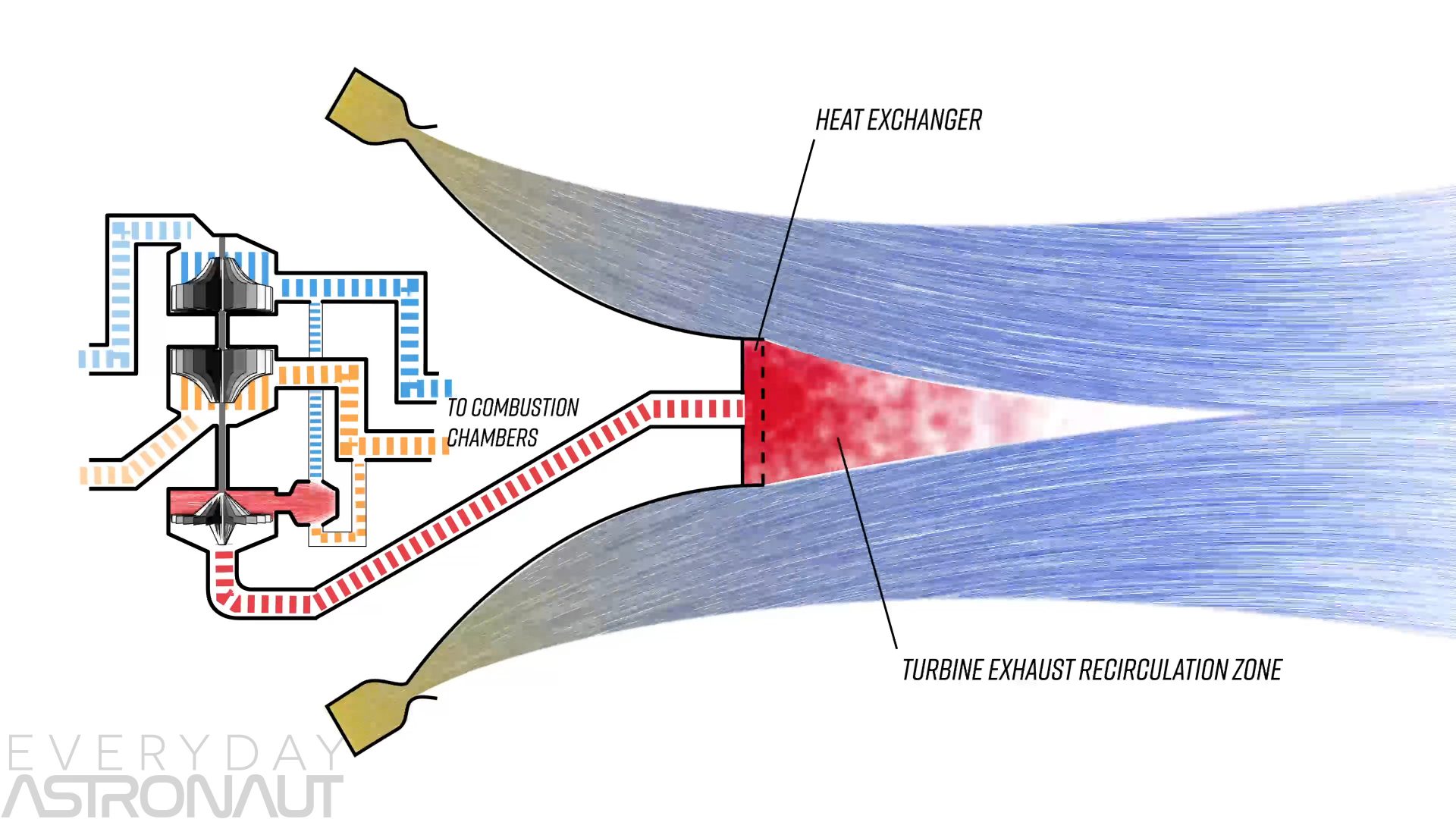
In order to make an aerospike engine, you need a differently shaped combustion chamber than a traditional one or multiple chambers that form the unique shape needed to make an aerospike. There are two main types of aerospikes. There’s the toroidal aerospike and the linear aerospike.
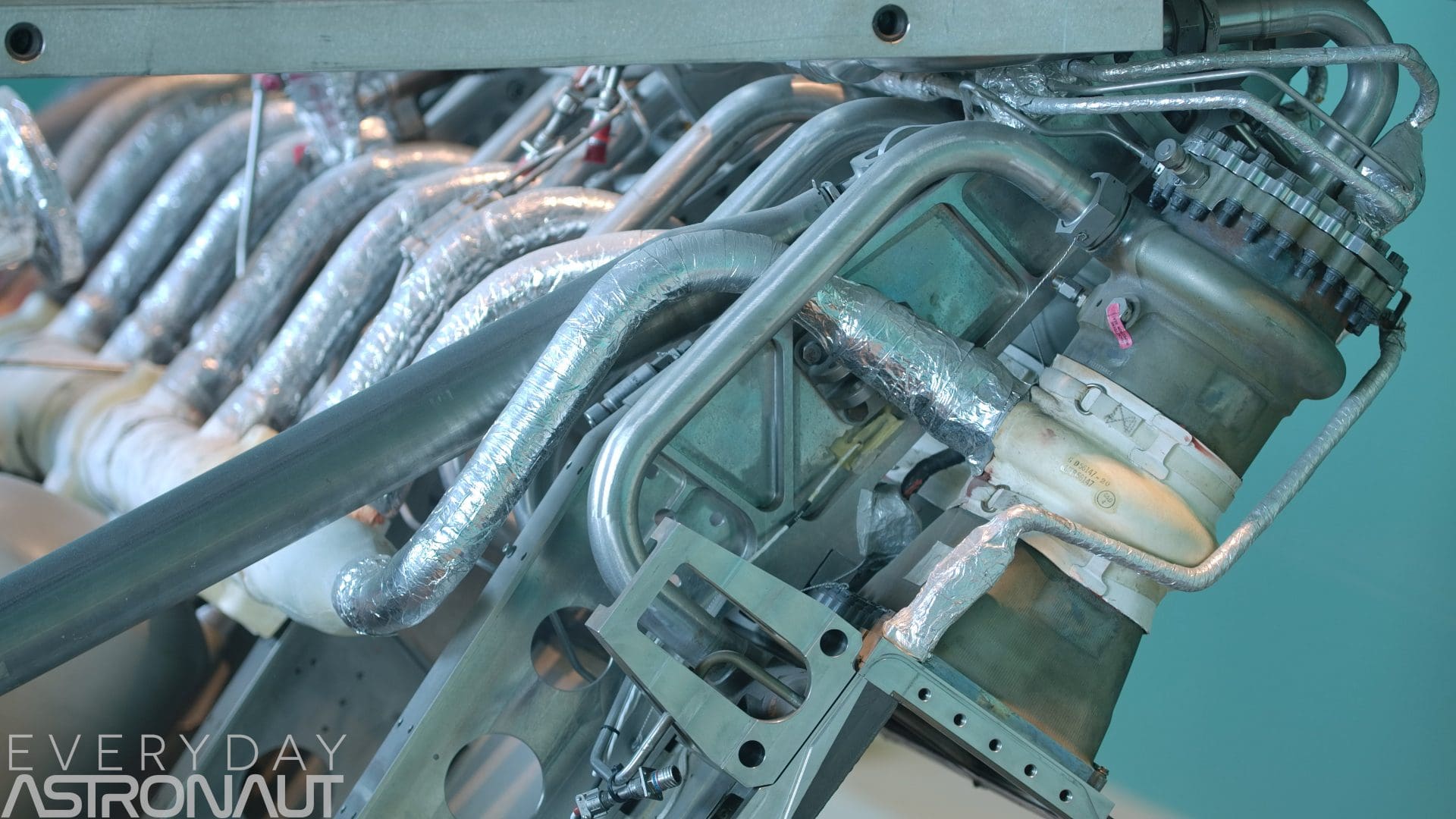
With the toroidal aerospike, the combustion chamber is like a donut and the throat is an opening pointing inwards-ish towards a spike.
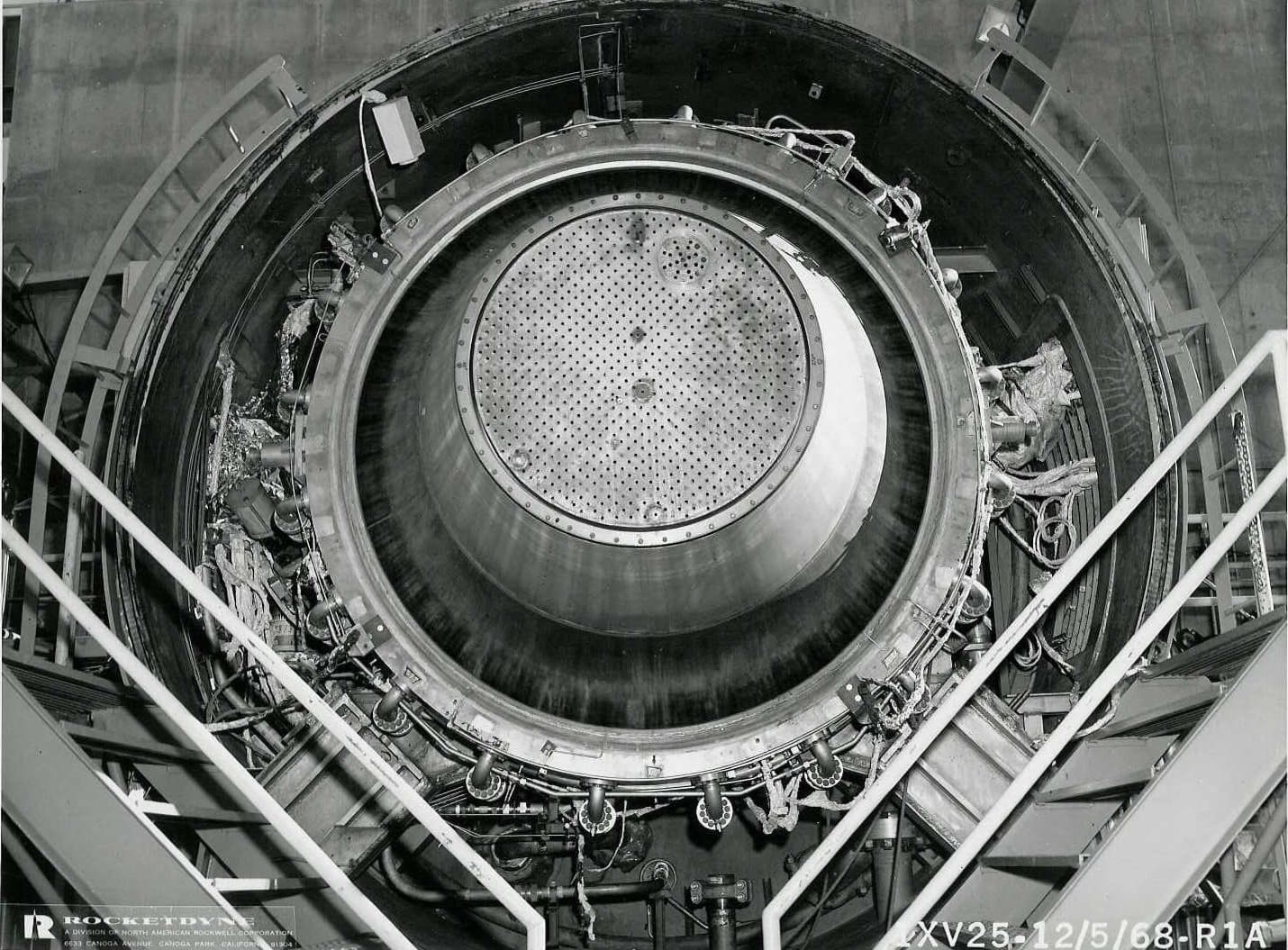
A linear aerospike has rows of combustion chambers that all point onto a flatter wedge shaped ramp and has at least two sides, and the exhaust ends up meeting each other at the tip.

Most rocket concepts that utilize an aerospike engine are a single stage to orbit concepts, that is a rocket that is only one stage and goes straight from sea level to orbit with no separation events. Now I’ve already done an article on why SSTOs suck, and trust me, they’re SUPER COOL, like YES I want that and maybe someday we’ll have it, but physics just simply dictates that there’s a lot better uses of rockets.
After all, if the key is reuse, not putting the entire vehicle through punishing reentry forces is a good place to start, that’s why we’re seeing fully reusable concepts like SpaceX’s StarShip be HUGE multistage vehicles. But an aerospike is a pretty good way to do a single stage to orbit rocket, since you can essentially utilize a vacuum optimized engine at sea level and not only will it not explode, it’ll operate about as well at sea level as a sea-level optimized rocket engine.
By the math, here’s where a working aerospike can nearly double the payload capacity of an SSTO compared to a good bell nozzled engine, but more on that later when we’ll look at whether or not an aerospike truly is the best option even for SSTOs.
The Problems With Aerospikes
Ok, so other than SSTOs, in general, if aerospikes are so great, why isn’t it being used on every rocket? Especially on the first stages where the vehicle transitions from sea level to vacuum-ish conditions.
Well, there’s two main issues that plague aerospikes. Weight and heat. Let’s start off with heat as it’s actually perhaps the biggest issue and it contributes to less than ideal performance AND additional weight.
That’s right, despite looking like there’s less to cool, an aerospike engine actually has a horrendous timekeeping itself cool. After all, a rocket engine is basically just getting exhaust gas as hot and high pressure as you can and eventually make it all move in one direction without it melting the engine trying to contain and direct it. And an engine melting, well, means you no longer have an engine. And as soon as your rocket no longer has a working engine, it tends to fall right back to Earth in a hurry.

The primary way most liquid fueled rocket engines cool themselves is through a process known as regenerative cooling. This is where liquid fuel is actually piped through the walls of the combustion chamber and usually most of the nozzle as well in order to cool them down.

There are also other tricks rocket engines do to keep themselves from melting. There’s film cooling with fuel or exhaust, ablative cooling, and even radiative cooling.
Ablative cooling, like heat shields, is where you allow parts to sublimate or ablate, and in doing so, they take heat away with them. A good example of this is the RS-68 engine that powers ULA’s Delta IV Heavy and powered the now retired Delta IV. Although it runs on liquid hydrogen just like the space shuttle, it’s exhaust isn’t clear like the space shuttle’s main engine exhaust. Instead, it has this orange glow to it. That’s actually from the composite nozzle that used graphite to ablate away, taking heat with it. This is a little less common in modern liquid-fueled rocket engines, and its of course not a good choice if you plan to reuse your engine since you likely would have burnt through the majority of it during the flight.

Film cooling can take a few forms either by injecting additional fuel inside the combustion chamber along the walls to keep those areas cooler, by pumping cooler exhaust down along the nozzle, or both. We’ve touched on the gas generator exhaust before in my article about raptor engines, but the exhaust from a gas generator or preburner is relatively cool since it needs to be a low enough temperature for the turbine to survive being subject to it.
It’s just super weird to think that you can take hot exhaust, like 1,000 C, mix it with hotter exhaust gas, like around 2,500 C, and it’ll actually end up being somewhere between the two temperatures. My dumb brain tends to think the temperature would be the sum of the two and not be the average of the two. Take a really hot gas, add a pretty hot gas and it doesn’t go to SUPER hot… good thing I’m not a rocket engineer. But hey, I guess I’m proof it’s never too late to start learning thermodynamics!
This cooler exhaust gas helps the nozzle, or usually the nozzle extension, be in contact with a cooler gas than if it were in contact with the main combustion chamber exhaust. You can see this utilized on the F-1 engine that powered the Saturn V as well as the Merlin 1D Vacuum engine. And looking at the Merlin 1D vacuum, you can see streaks in its niobium alloy nozzle which is radiatively cooled but also takes the gas generator exhaust and uses it to cool the nozzle. The streaks are from little fins inside the exhaust manifold that maintain the structure.
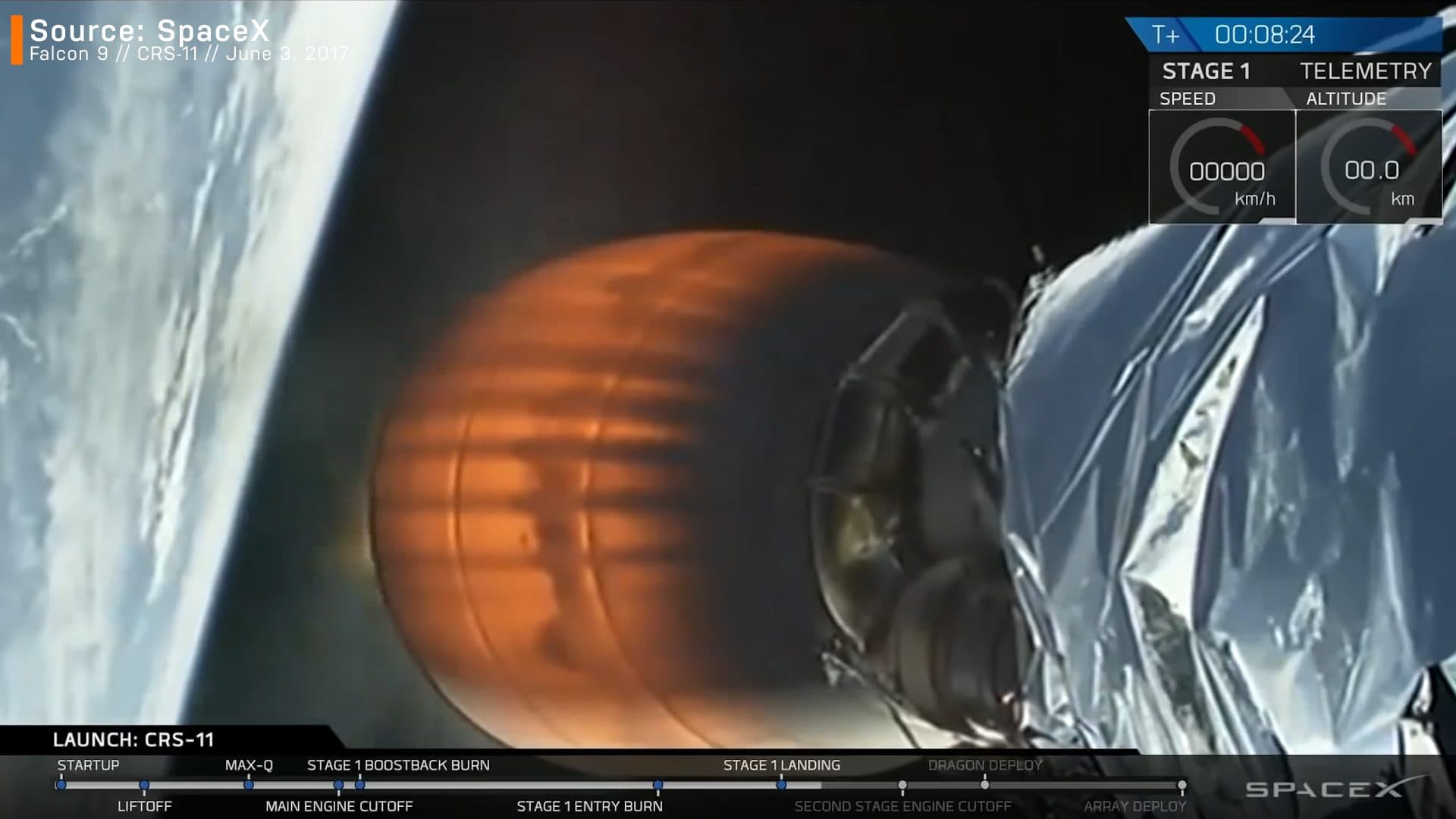
Side note, I used to think these streaks were from the pintle injector, but come to find out, it’s from the exhaust manifold’s support braces interacting with the film cooling.
The other way to keep the walls of the combustion chamber and the nozzle cool is by having additional fuel injectors along the perimeter of your injector plate. The injector plate is generally the entire top of the combustion chamber and is where the fuel and oxidizer mix, hopefully really well, and where the primary combustion occurs. I’ll do an in depth rundown on injectors here soon, but for now, just know in general they mix to a predetermined amount of fuel and oxidizer which balances performance and heat. The further away from their ideal ratio the fuel and oxidizer are, the cooler the combustion will be.

Since oxygen is a heavier molecule than most fuels and can’t be accelerated as quickly as a lighter fuel molecule can, engines tend to run fuel rich when they need to lower exhaust temps. And in order to locally cool say the outer perimeter of a combustion chamber where the exhaust comes in contact with the chamber walls, you can add a few more fuel injectors so there’ll be a layer of more fuel rich exhaust that’s in contact with the walls.

The most problematic part of a rocket engine is the throat. This is where the (heat absorbed by the wall of the nozzle is the highest) temperature of the exhaust is the highest. Luckily, this high-temperature exhaust is only coming in contact with a small amount of surface area, and with a finite amount of cool fuel being pumped through the walls, having only a small area in contact with the hot exhaust gas is a good thing. This is backward from what we normally tend to deal with in life. If you want to cool something off, you normally want a big surface area to radiate a lot of heat away as a radiator does on a car, but that’s not what’s happening here, we have a heat source and it’s going to melt whatever it touches.
Think about it like if you had a red hot fire going and you have a garden hose running to try and keep the stuff you put in that fire from melting. Stick a metal rod in there a little, the hose will probably do fine in keeping the rod from melting, but as you put more and more of that rod in the fire, eventually the hose will not be able to keep up with the task of keeping the rod from melting.

This is where a larger engine actually has a big advantage over a small engine. The volume of an engine, and therefore the amount of propellant per second in the engine, goes up by the cube of the engine’s radius, but the surface area needing to be cooled only goes up by the radius squared, so larger rocket engines have a lot more propellant to cool only a little more surface area.

Let’s make up some numbers here, say the proportions are the same, but one engine has a throat diameter that’s 50mm and one has a throat of 100mm. The engine with the 50mm diameter throat will have an area of 1,963 mm2 and a circumference of 157 mm. The engine with a 100mm diameter throat will have an area of 7,854 mm2 and a circumference of only 314 mm. In other words, the 100mm throat engine could flow 4 times more exhaust while only needing to cool twice as much surface area.
But wait, it’s still twice as much to cool, right?… but guess what, if you’re flowing four times as much exhaust through the throat, it also means you’re flowing four times as much fuel as coolant through those areas as well. So really, in a sense there’s twice as much fuel as coolant to cool a given area when you double the diameter of your throat. That’s a good thing. So a larger engine actually gets easier and easier to cool. Of course they start to bring their own problems, such as combustion instability, but in general a bigger engine is easier to cool.
And right here is the biggest problem with aerospikes. By design, the throat of their combustion chamber has substantially more surface area to cool. For a toroidal aerospike, it’s combustion chamber basically has a giant plug in the middle of it which greatly increases the surface area of what needs to be cooled.
Let’s do some simple math based on those last chambers. Let’s pretend we’re trying to keep the same throat area of 7,854 square millimeters we had with that 100mm diameter throat. Well in order to get that same throat area, we’d have to have say a 141mm outer diameter throat and then a 100mm inner diameter plug. This means we now more than doubled the amount of surface area we need to cool. We went from having a circumference of 314mm to a circumference of both 314mm plus an additional 444mm for the outer diameter for a total of 758mm.
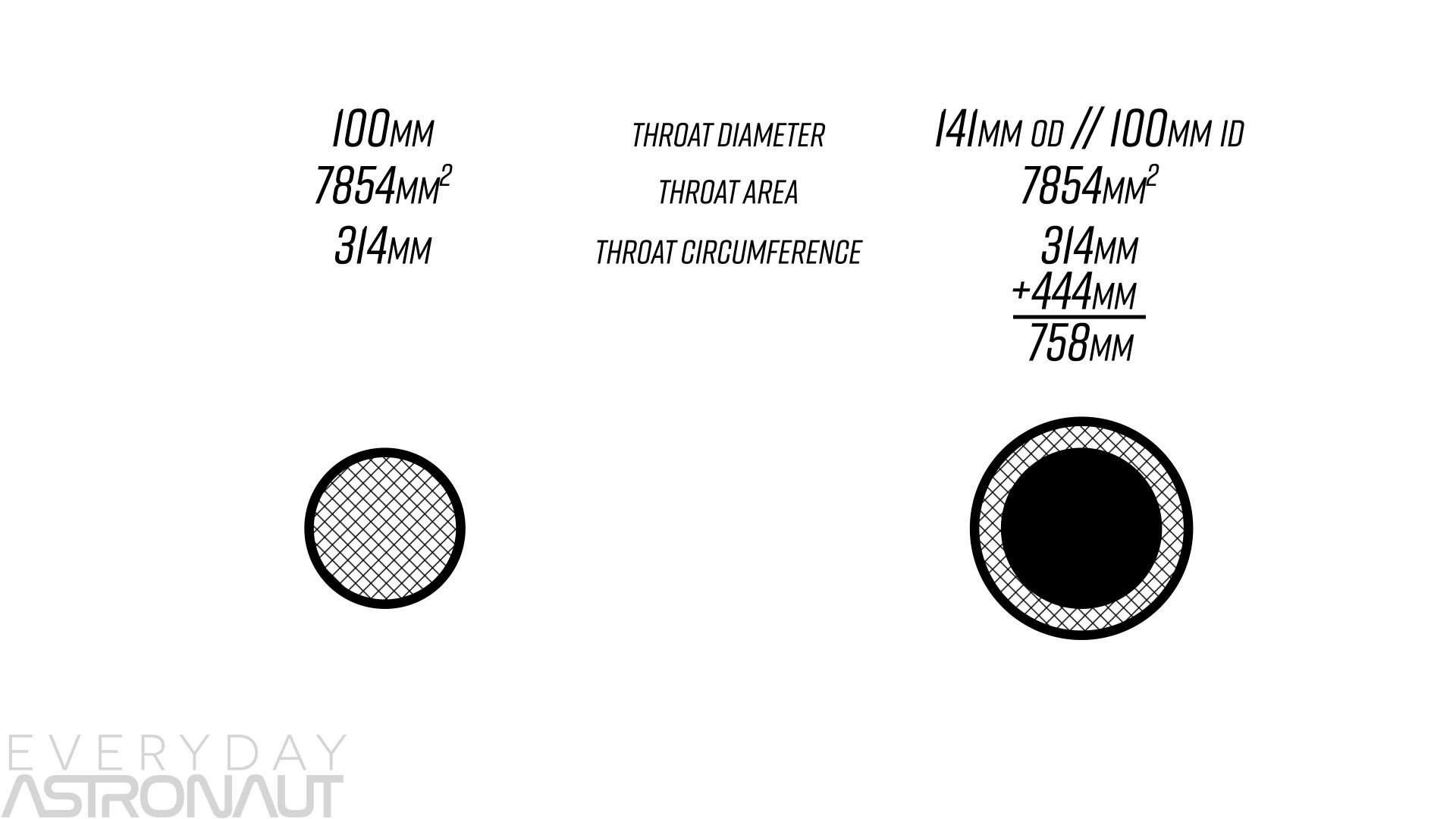
These numbers are a bit arbitrary here because we really could stretch this any way, but one thing you can’t overcome is the fact that you’re inherently at LEAST doubling the surface area at the exact place where it’s the hardest to keep cool.
But truth be told, engineers don’t often suspend a plug in the middle of a normal combustion chamber, it’s more common to make a ring for a combustion chamber, but even so, a ring still has an inner diameter and an outer diameter that you now have to cool.

The J-2T was actually a perfect example of this. It took the turbomachinery from the J-2 engine and was put inside a toroidal spike. But just look at this picture of the J-2 vs the J-2T. You can tell just how much substantially bigger the throat is and now we have TWO throats of that larger diameter just to make up the same throat area as the standard J-2. The math works out to being almost 15 times harder to cool the J-2T than it is to cool a standard J-2. That’s certainly not trivial.
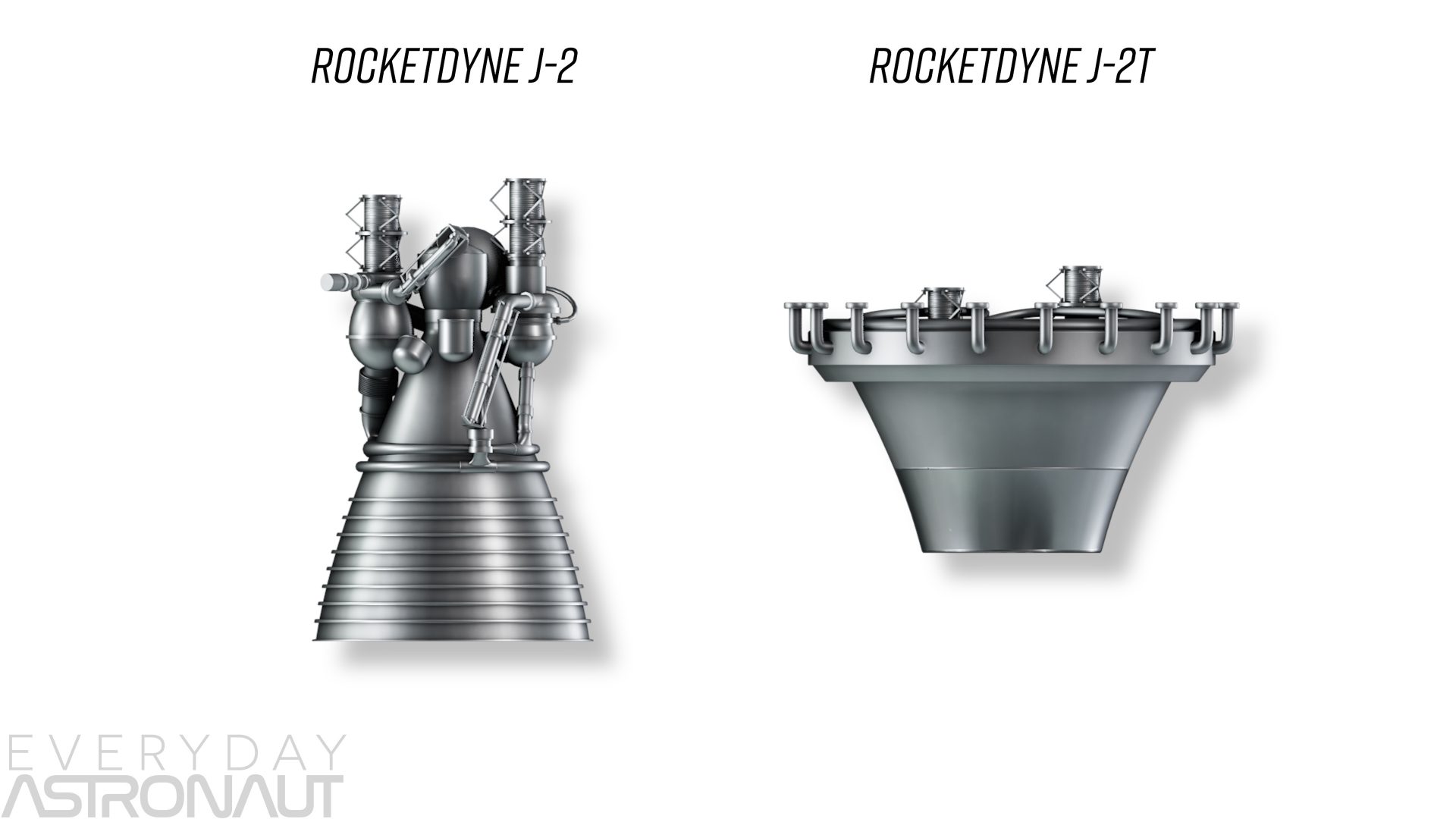
And you have to remove that heat somehow, if regenerative cooling through the walls isn’t enough, you have to add more film cooling, change your overall burn ratio to cool all of the combustion or maybe use heavier or more expensive metals with higher melting points, any and ALL of these come at the expense of performance. Although we’re still doing research on the combustion dynamics of aerospike engines, so far they seem to be a few percent less efficient at reacting the propellant in the combustion chambers, wasting some highly cherishable chemical energy in the propellant. It’s possible this could be fixed with more work, but it could just be due to some of the many compromises required to make aerospikes actually function, period.
So really, the other thing that is a limiting factor for aerospikes is weight. In general, it seems like aerospikes have a much harder time achieving a high thrust to weight ratio when compared to their bell nozzle counterparts. This is mostly due to the larger amount of surface area for the combustion chamber or chambers, the additional plumbing to feed all the chambers, and the additional support and structures between the spike.
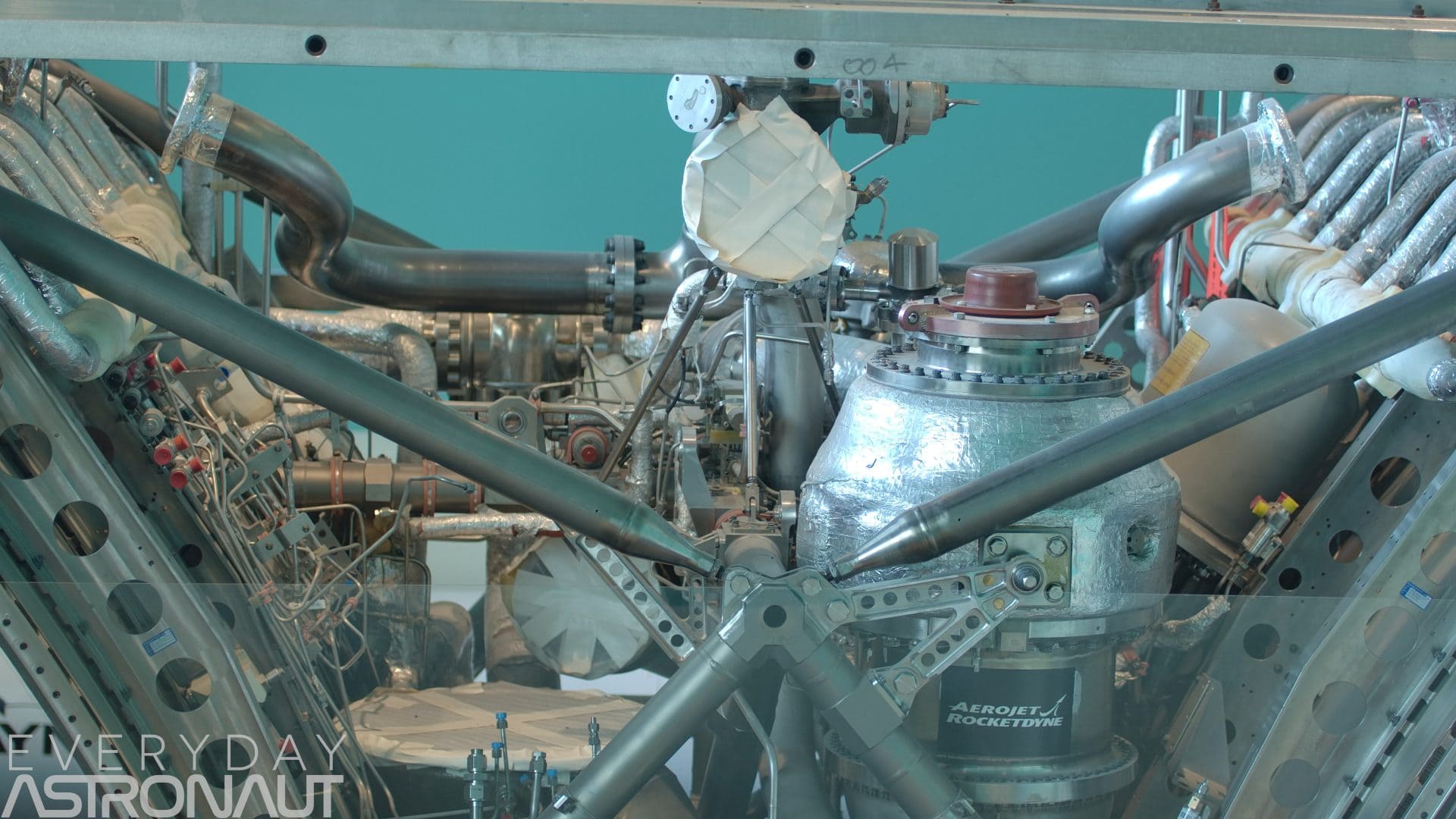
Take a look at the XRS-2200 and look at how much stuff there is between the ramps. Although it seems like there’d be less nozzle, which may be true, there’s honestly more of literally about everything else. And imagine if you have a leak in one of these tubes, pipes or valves. There’s a substantial more amount of points of failure on an engine like this. Or say you have a hydrogen leak, which is common because hydrogen is so hard to contain, imagine trying to track down the source of the leak in an engine like this… yeah, that’s a lot of additional hardware.
But weight is extremely important with rockets and the thrust to weight ratio is a very important metric in rocket engines. After all, extra weight directly affects your payload capacity and overall performance of the rocket, so lightweight and powerful engines is always a good metric.
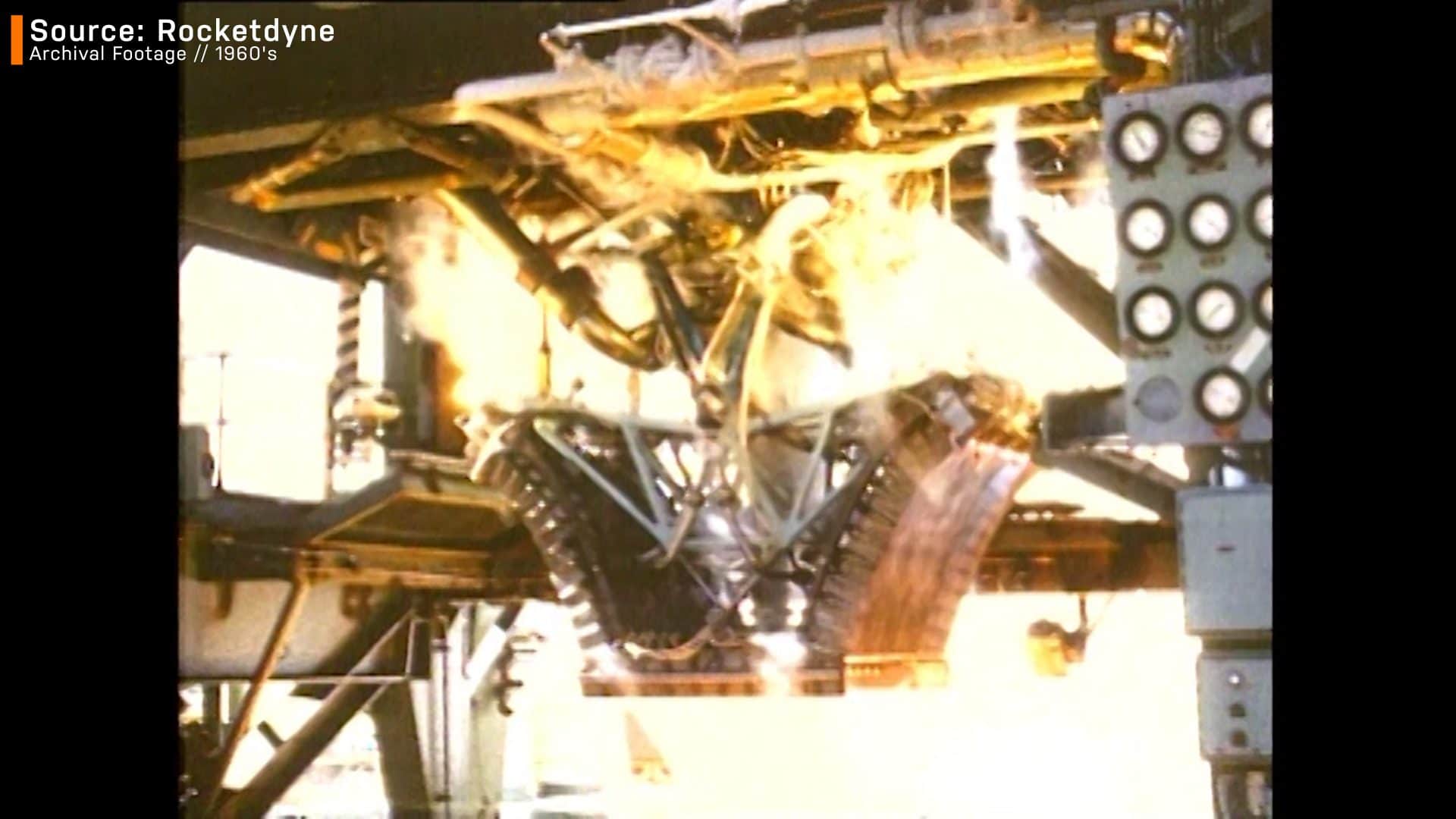
Another thing that can be difficult to do with aerospikes is how to gimbal or steer them. Because of the large attachment points to the vehicle, it can be impractical to try and move the entire spike with thrust vector control. Although, one good thing is a gimbaled spike will never exceed its own perimeter, unlike a nozzle which can run into nearby engines. A common solution for thrust vectoring is to throttle individual chambers to perform differential thrust, by off-putting the thrust, it will induce pitch or yaw to the vehicle. Although it’s not as effective as steering the entire engine, it is a viable option.
The RS-2200 linear aerospike was to use both actuated thrust vectoring and throttling. On the pitch and roll axis it had actuated control and for yaw control it’d throttle individual chambers all the way down to 18%.
And the last big deal with aerospikes is actually the lack of REAL flight data. Now although this seems like a simple solution, or a perfect submission for the “Why Don’t They Just” segment on “Our Ludicrous Future Podcast” that I’m the co-host of… I mean, “ why don’t they just FLY an aerospike…” – which by the way if you don’t listen to Our Ludicrous Future podcast on YouTube or on your favorite podcast player, definitely get on that if you want your weekly fill of space news, EVs and futurism. Shameless plug.
The thing that hasn’t really been proven out is what happens with aerospikes between supersonic speeds or above mach one, up to hypersonic speeds of mach 5. This is a non-trivial thing. But one really really cool experiment was the LASRE experiment which was taking a scale mockup of the X-33 tail and aerospike engine, putting it on an SR-71, and flying above supersonic speeds. There were actually seven research flights with the LASRE experiment on an SR-71 and although they never actually fired the engine, they did perform cold firing tests at Mach 1.58 and ground firings which gave them all the information necessary to move on.

Now I don’t care what you say, but a freaking aerospike engine on an SR-71 is honestly about the coolest thing ever. But regardless of how cool it looks, the aerospike engine still lacks any real runtime data in these supersonic and hypersonic regimes or almost any real full scale flight data period…
Comparing Aerospike Engines To Bell Engines
Ok, I think it’s time we actually put up some aerospikes against more traditional engines and see how they compare.
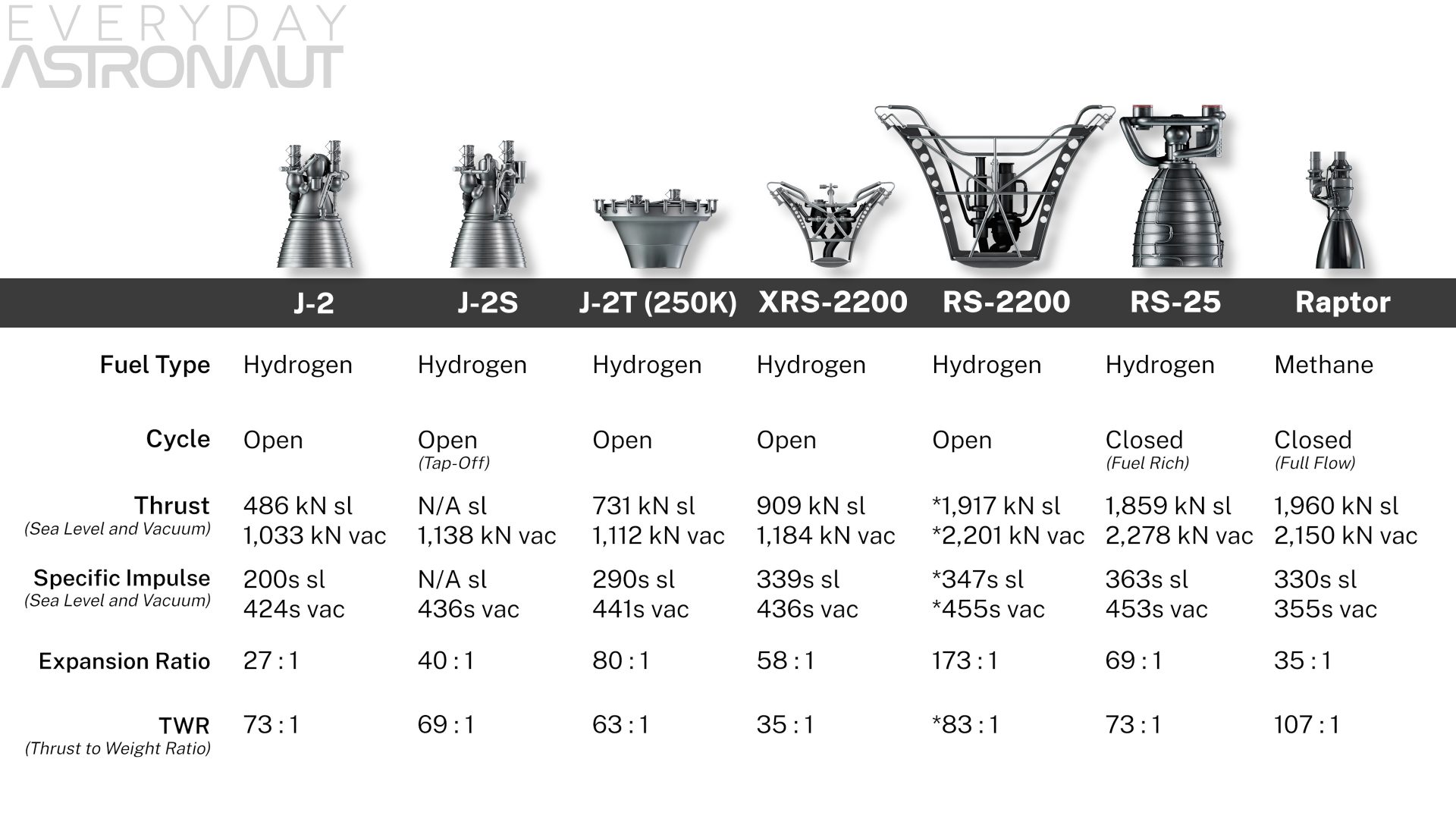
So let’s start off with our line up of traditional bell engines. For this we’re going to look at original J-2, the J-2s that was intended to replace the J-2 engine, then we’ll look at the Space Shuttle main Engine, the RS-25 as well as SpaceX’s Raptor engine. The reason I chose these engines is that they’re substantial engines that have a lot of data, they’re either alternatives to the aerospike, the basis of aerospikes, and / or considered the best engines ever made. This way we get a variety of engines to compare different aerospikes to. And each of these engines performs in the vacuum of space or in the case of the RS-25 and the Raptor engine, they operate in space and at sea level like an aerospike.
For aerospike engines, we only have three engines that really made it through a legitimate certification and testing program, but only two that I have good hard numbers on and one that would’ve perhaps been the king of aerospikes. So the engines with the most data are the J-2T-250K toroidal aerospike and the XRS-2200. By comparing these engines to the J-2S which it was based off of, we should get a good idea of its performance. The other aerospike we’re going to look at is the RS-2200, which was the full scale engine that would’ve actually powered the Venturestar.
Now all of THESE numbers will have a big asterisk next to them because this engine never actually hit the stand and it relied on a lot of new and unproven-ish technologies to get these numbers, such as a lightweight carbon ramp and ceramic tubes. So the numbers quoted here are what they would’ve needed to reach in order to make the Venturestar work, and truth be told, getting an engine to hit your targets can be very very difficult.
And I think it’s fun to compare all of these to the Raptor engine since we asked the question is it the king of rocket engines in that video. But the numbers on Raptor are just the current numbers and just like the Merlin engine, we do expect to see SpaceX continue to push this engine and develop it beyond these numbers in the near future.
I should also point out that these engines are drawn to scale of each other!
So let’s start off with each engine’s fuel. Every engine here runs on liquid hydrogen and liquid oxygen is otherwise known as hydrolox except the Raptor engine which runs on liquid methane and liquid oxygen, or methalox. I wanted most of the engines to be hydrolox so we’re comparing the most apples to apples engines since hydrolox engines have the most potential for a high specific impulse. But it’s still fun to compare them to the methalox Raptor here.
Next let’s look at their cycles. Again, if you need a rundown on cycles, I go into most of these in my video about the Raptor engine and its Full Flow Staged combustion cycle. But the one cycle type that I didn’t talk about is the tap-off method which actually uses the primary combustion chamber to power the turbine. The engine here that uses the tap-off method is the J-2S which was intended to help simplify the engine and bring the cost down since it eliminated the preburner or gas generator. The original J-2, the J-2T-250K, the XRS-2200, and the RS-2200 all use a gas generator. The RS-25 is closed cycle, fuel rich, and the Raptor engine is, of course, full flow staged combustion cycle.
Now let’s look at their thrust output. We’ll do both sea level and vacuum thrust in kilonewtons. The J-2 produced 486 kN at sea level and 1,033 kN in a vacuum, the J-2S couldn’t actually fire at sea level and in space produced 1,138 kN, the J-2T-250K produced 731 kN at sea level would do 1,112 kN in space, the XRS-2200 was 909 kN at sea level and 1,184 kN in space, the RS-2200 would’ve hopefully produced 1,917 kN at sea level and 2,201 kN in space, the RS-25 produces 1,859 kN at sea level and 2,278 kN in space and the Raptor engine produces 1,813 kN at SL and ~2,000 kN in space.
Now let’s look at their efficiency measured in seconds or the engine’s specific impulse. You can think of this like the fuel economy of a gas powered car. So a high specific impulse would be similar to a high mpg or kmpl. The best way to think of specific impulse is imagine you had one kg of propellant, for how many seconds can the engine push with 9.81 newtons of force? The longer it can sip on the fuel while still pushing that hard, the higher its specific impulse, and therefore the more work it can do with the same amount of fuel. IE, it’s fuel economy. So the higher the specific impulse, the less fuel it takes to do the same amount of work, which is a good thing. A fuel efficient engine is extremely important!
The J-2 was 200 seconds at sea level and 424s in space, the J-2S couldn’t fire at sea level and was 436s in space, the J-2T was 290s at sea level and 441s in space ,the XRS-2200 was 339s at sea level and 436s in space, the RS-2200 was planned to have 347s at sea level and 455s in space, the RS-25 is 363s at sea level and 453s in space and the Raptor engine is 330s at sea level and 350s in space.
Now as we mentioned, a huge factor in the specific impulse of an engine is the expansion ratio. So let’s see if there’s a strong correlation between expansion ratios and their specific impulse. The J-2 was 27:1, the J-2S was 40:1, the J-2T was 80:1, the XRS-2200 – 58:1, the RS-2200 would’ve had a crazy 173:1, the RS-25 is 69:1 and the Raptor is 35:1. It should be noted that although the J-2s has a higher expansion ratio, it’s dimensions look almost identical to the J-2. That’s because the throat diameter is actually smaller on the J-2S compared to the J-2 in order to increase the expansion ratio but also keep the same general dimensions which would make it a drop in replacement.
And lastly, let’s look at their thrust to weight ratio. Now this one we definitely need to remind you that these numbers could be off by a bit as each company might quote the engine with varying amounts of hardware, or have different metrics for this, but in general, we can use these numbers as a decent rule of thumb. The J-2 was 73:1, and although the J-2S was simpler with no preburner, it was a little heavier, likely due to its larger nozzle and had a 69:1 twr, the J-2T was 63:1, the XRS-2200 was 35:1, the RS-2200 was planning to hit 83:1, but would’ve needed to hit 75:1 in order to make its SSTO capabilities possible, the RS-25 is 73:1 and the Raptor is 107:1.
So now that we have all of these numbers, we can really see how aerospikes compare to more traditional engines. In general, the J-2T and XRS-2200 should be compared to the J-2S since that was really what was to replace the J-2. When we do so, we can definitely see why both of these engines were advantageous. They offer great vacuum performance AND they can still be used at sea level, something the J-2S physically couldn’t do. And in this case, the J-2T even seems to have been a better choice for an upgrade to the J-2 than the J-2s in literally every metric except thrust to weight ratio. It was a compelling option!
And now when we compare all of these to the Raptor engine, we can clearly see that the Raptor engine with a sea level nozzle and methalox isn’t as efficient in a vacuum, but with a mighty impressive thrust to weight ratio and solid sea level ISP, it’s sort of out there on its own.
Now had the RS-2200 actually made it through development and truly hit all these numbers, it would’ve been a very impressive engine. Not only does it have the best vacuum efficiency, it also would’ve managed to beat the RS-25’s thrust to weight ratio. That being said, I’ve heard from multiple sources that had Lockheed just simply stuck with the RS-25 for the Venturestar, it would’ve been just as good of an option and was already a complete engine compared to the RS-2200 which would’ve still had a full risky and costly development ahead.
But with that in mind, I think it’s time we hear from real experts who have either worked on aerospikes or who have opted against using them.
What the Experts Say
So on the note of would it be better to have used an RS-25 rather than the RS-2200, let’s hear what Tory Bruno, the CEO of ULA who actually worked on the X-33 and Venturestar program has to say.
“The toughest part about the design and operation of an aerospike engine is thermal management. A traditional AS engine is conical in shape and can really struggle with heating as the spike tapers down. The linear AS design, together with the strategy of truncating the taper, goes a long way to simplifying this problem, but it is still there. However, this linear AS thermal advantages are accomplished in exchange for having to use many smaller engines arrayed in two lines, which adds significant complexity over a single (larger) engine conical (sometimes called “toroidal”) configuration. The next technology issue is the management of the flow field across and around the truncated end. We usually want to flow some gas through the truncated surface to keep it organized and not be disruptive of the flow along the termination of the ramps, while also collecting a little additional thrust at higher altitudes.”
I also asked him if he thought the RS-2200 could’ve met the metrics it was intended to hit. He said:
“Mostly. I’m sure the engine would have worked and been practical. The complexity of so many separate engines, however, would have presented a weight growth challenge as well as significant propellant flow management complexity.”
And I just had to ask him if after working with aerospikes if he loved them or hated them.
“I love them. Aerospikes are just plain cool, and linear aerospikes are the coolest type.”
I agree Tory! I also asked Elon Musk why he hasn’t opted to use an aerospike engine for anything at SpaceX and here’s what he said.
So really, you can tell Elon’s biggest focus is on combustion efficiency. It seems like he’s focusing his and his engineering team’s work on combustions efficiency over the advantage of an altitude compensating nozzle.
The other person that I think has some cool expertise on the subject is Peter Beck, the CEO and co-founder of Rocket Lab. Not only has Peter built aerospikes himself, but he has a great view of why a company like Rocket Lab hasn’t pursued them.
But while sitting there chatting with Peter, it got me realizing that the Electron uses 9 engines, and I wondered if they could do anything like gimbaling inwards to utilize some unique aerospike like effects… here’s his response…
“Oh there’s stuff you can do”
Interesting… Maybe there’s actually something to that! But perhaps the best summary of the aerospike comes from Vector Aerospace who worked on several aerospike engines, including one of their first engines in April 2002 which was test fired in front of Elon Musk and Tom Mueller of SpaceX.

The engine unfortunately only lasted 200 milliseconds before it blew the graphite plug right off the injector face. But this wasn’t their last attempt. They continued to pursue different aerospikes including a 10 chamber, 1,300 lbf thrust aerospike engine which also, unfortunately, failed on it’s 2009 flight test.
In 2016, Vector released this statement, which I honestly think summarizes aerospikes perfectly –
“While aerospike engines can provide performance advantages, the larger number of parts and components means that they are usually heavier than their regular bell-nozzle counterparts in terms of thrust-to-weight and, more importantly, require very high component reliability.”
The general consensus I’ve gotten from people who have worked on aerospikes is it’s just not worth it. Not only is the development and research costly and risky, but the net gain might not be any better than a more conventional tried and true bell engine.
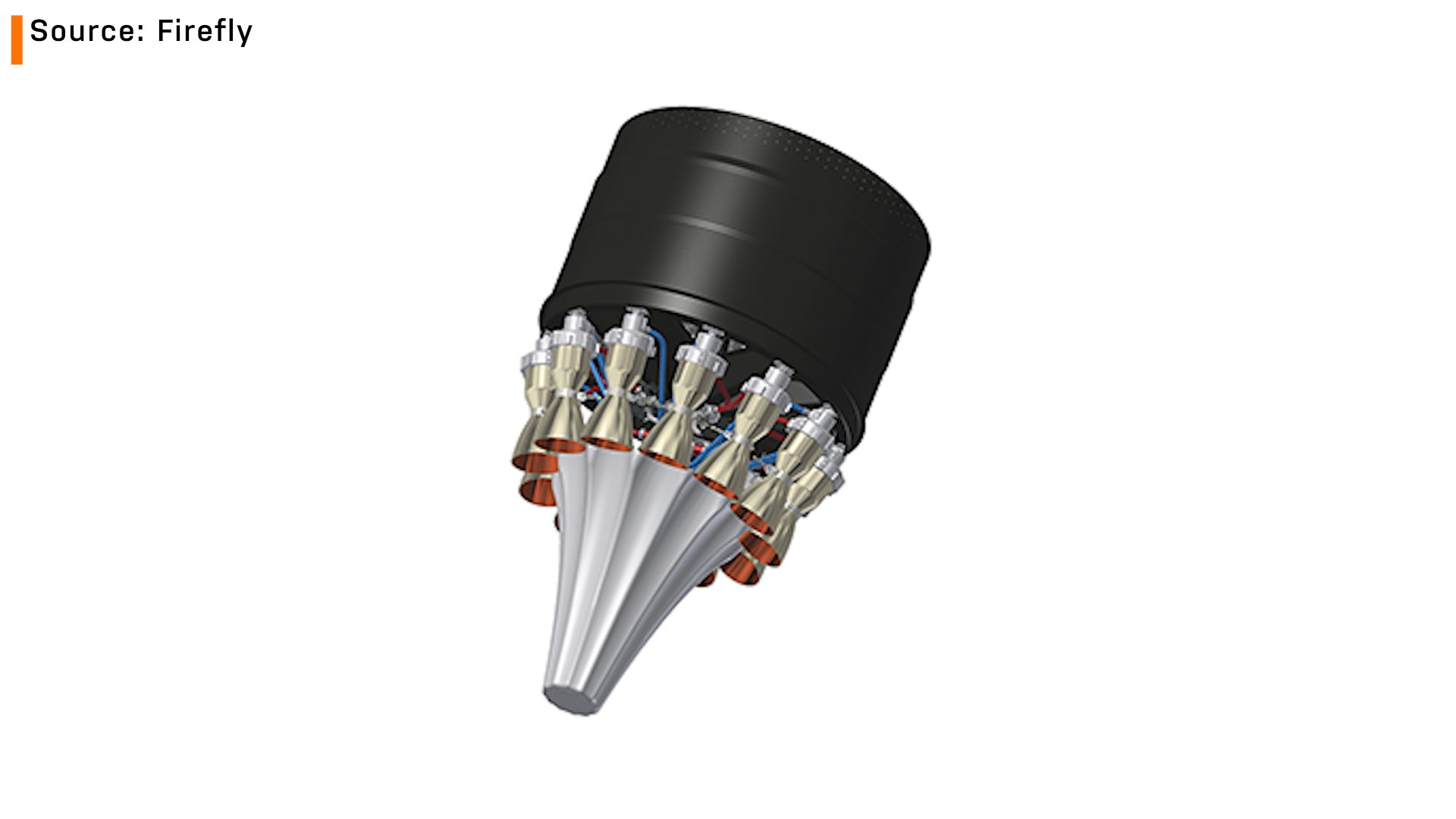
And this is echoed when you learn about Firefly aerospace who had a really promising aerospike engine known as the FRE-2 which was to be a 12 nozzle methane powered toroidal aerospike that was to power their Firefly Alpha. After a company reset, the aerospike plans died and now the company is planning to utilize a traditional bell nozzle as well… What’s going on, WHERE ARE OUR AEROSPIKES?!
So how many companies are currently working on aerospikes as we speak… so far as I can tell… one. Ish. Kind of. Well, maybe two…
ARCA has a pretty intriguing video series called “Flight of the Aerospike” and they are promising to make a low cost and simple SSTO aerospike rocket. But oddly enough… the latest video in the “flight of the Aerospike” series shows the company testing their new systems using a traditional bell nozzle and simplifying their rocket to running on steam…

Now I want this company to succeed and I really want them to fire off their linear aerospike, but from what I can tell, they’ve got a VERY long way to go before they would ever fly one. And although the company has been around for 20 years and has yet to fire an aerospike, perhaps they’ll make some progress and get anything flying someday… but I’m starting to think this too will fall in the “well, it turns out it wasn’t worth it” category.
The other company currently working on an aerospike is RocketStar who is pursuing an aerospike, but so far their engines seem to only be in the high powered model rocket category, although they do have plans for a Starlord rocket which would use an aerospike… but this is very much a paper rocket so far as I can tell.
But aerospikes still have some promise… right? I mean, most of the concepts we looked at utilized the open cycle or gas generator engines, couldn’t there be ways to improve upon aerospikes that would make them worth it?
Future Aerospike Prospects
There’s two pretty promising ideas / technologies that might actually help aerospikes find their place on the bottom end of an orbital rocket. The first being 3D printing.
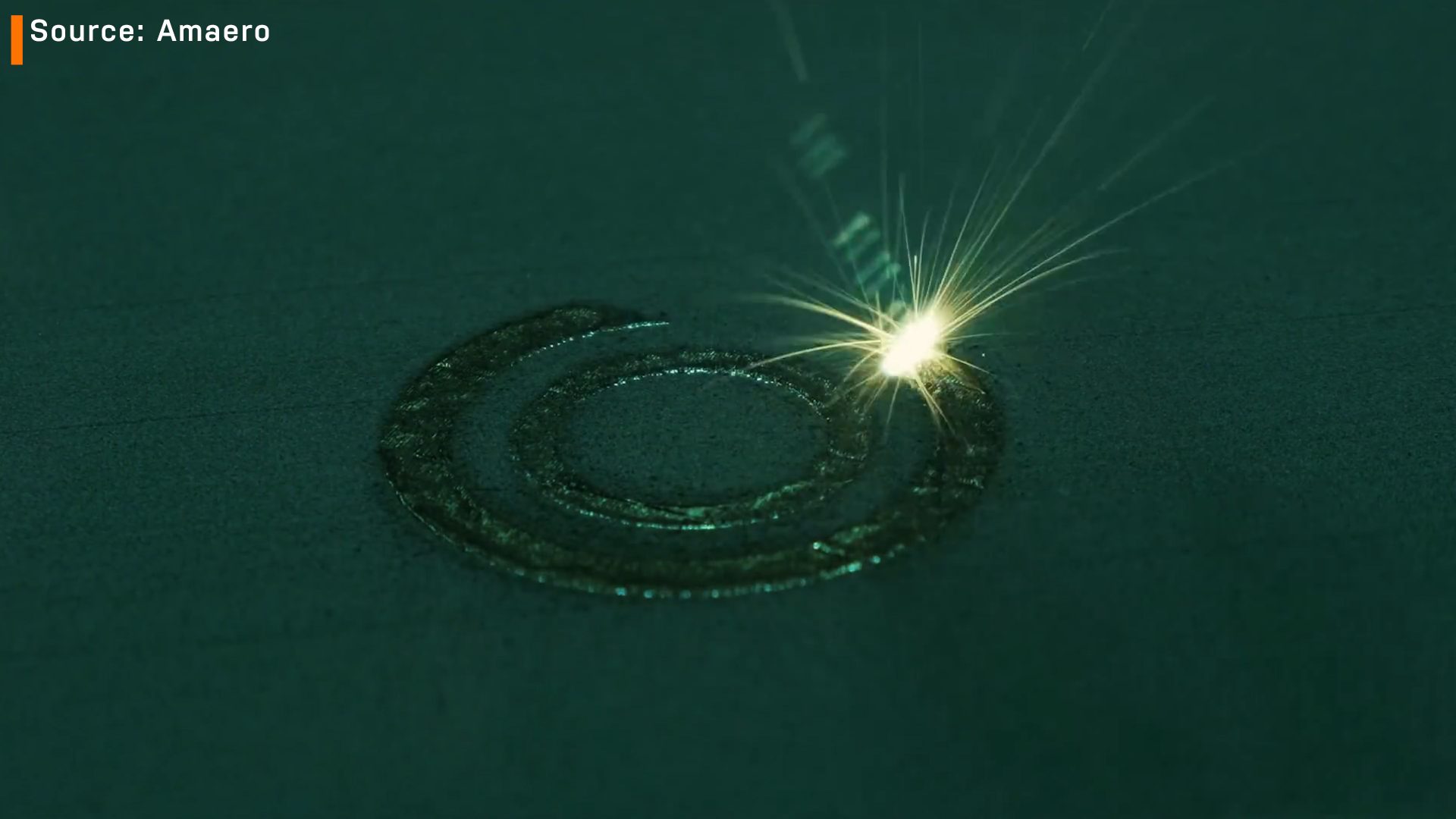
3D printing allows for advanced designs that can help make cooling channels and combustion chamber shapes, that would normally be physically impossible to manufacture, super easier to manufacture at the push of a button. There are companies like Amaero who have built additively manufactured aerospikes out of Hasteloy X which is a high strength nickel based superalloy. It’s really cool to see how they can print these crazy shapes that are required for an aerospike.
The other concept, that very well might work hand in hand with 3D printing is a dual expander cycle aerospike engine and one in particular is known as the Dual Expander Aerospike Nozzle or DEAN. What’s cool about DEAN is it takes the biggest problem of aerospikes, which is heat, and makes use of it in the expander cycle.
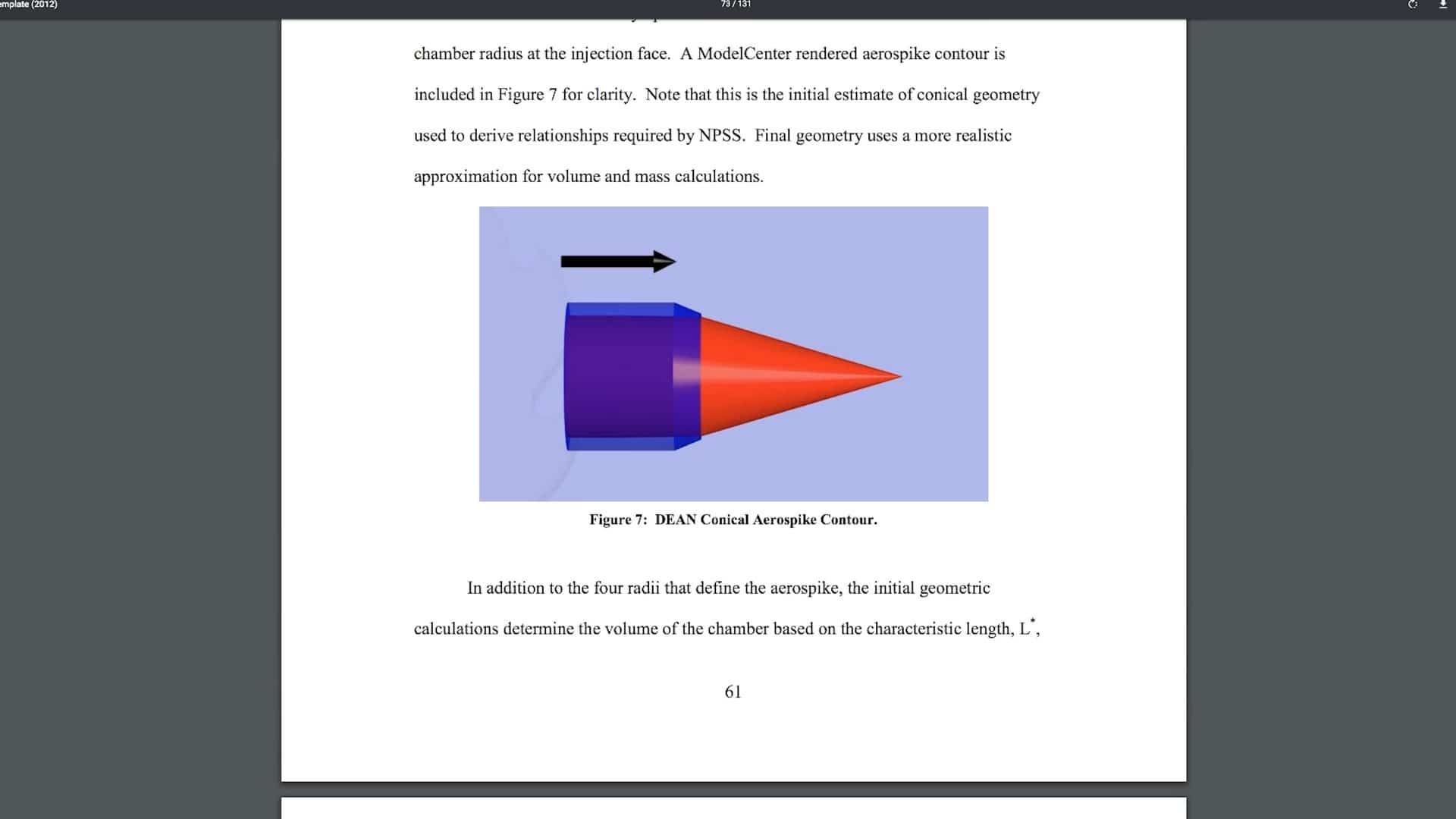
The expander cycle is where a rocket engine takes the liquid fuel that cools the chamber, heats it up to the point of phase change into hot gaseous fuel and then using that to spin the turbine which then will power the engine. The problem with expander cycles is actually the opposite of aerospikes. They have a thrust output limit based on how much liquid fuel an engine can actually heat up and turn into gaseous fuel. Due to the square – cube law, you eventually run out of surface area to heat up the fuel.
The theoretical limit is approximately 300 kN of thrust before the surface area to volume of fuel ratio gets to the point where you can no longer power the pumps adequately. But by having more surface area to heat up fuel, like an aerospike engine inherently has, you can actually get away with a more powerful engine, which might be a cool trick for future aerospike engines.
But to date, the DEAN concept has only existed in theoretical papers which targets an engine with 111 kN, 383s of impulse in a vacuum and a TWR ratio of 108, which I should note, these specific impulse and TWR numbers would put it on par with the Raptor engine. But again, research papers and actual working hardware are very very different things, which is why many of these concepts are studied only in research labs and often don’t make it much further nor do they end up being commercially viable, for now.
Summary
Ok wow. This ended up being a LOT longer article than I would’ve ever imagined. So let’s do a quick summary.
Aerospikes. Super cool on paper, a super tantalizing concept that seems to beckon even the most astute rocket engineers, perfect for your SSTO concept that also might need to be reconsidered, AND likely to drain your bank account and make you age a few decades trying to develop it. BUT… BUT… they are super cool and as manufacturing and material sciences advance, perhaps we’ll see companies able to utilize and exploit their advantages and close the gap on the bell nozzle which has dominated the aerospace industry.
Perhaps the biggest reason we generally don’t see too many aerospikes popping up in modern times is simple… If they truly offered a clear performance advantage, I would assume everyone would be developing them, but the fact of the matter is, they kind of wind up right back in the same place as a normal rocket engine.
Now you could probably say the exact same thing about SpaceX’s Raptor engine which utilizes a full-flow staged combustion cycle… that was considered far too difficult to really be worth it previously. And that rocket engine is EXTREMELY complex and unbelievably hard AND expensive to develop. BUT, the thing is, the full flow staged combustion cycle will actually perform better in virtually all metrics than other rocket engines, period. Whereas the aerospike might gain some advantages in say altitude compensation, but it lacks advantages in other areas which puts it right back on par with other engines. So as far as where to spend your time and research, that’s why most engineers have pursued things like closed-cycle engines, full-flow staged combustion cycle, or the path of easiest manufacturing and development like Rocket Lab’s electric pump-fed engines.
And one last fun fact about aerospikes, and this is sort of similar to how my SSTO video ended… it’s not really the aerospikes that suck, but their application here on Earth is probably the wrong planet to utilize them. Ironically, if Earth’s atmosphere was ANY thicker, they would actually become significantly more advantageous, even for a multistage rocket, but with Earth’s atmosphere, as it is, the bell nozzle is just too close to the same performance, making it a much easier and less risky choice in the aerospace industry. If it wasn’t for their thermally backward nature, their advantages may actually outweigh their disadvantages, but perhaps their tendency to melt is the biggest reason why we just simply haven’t really seen one leave Earth’s atmosphere.
But all in all, I think the best way I can summarize the Aerospike is to compare it to like the rotary engine seen on cars like the Mazda RX-7 and RX-8 and their predecessors. For those of you familiar with car engines, you may know about rotary engines. They’re super simple, only 3 moving parts, small, lightweight and powerful. On paper it really should’ve been a more popular choice in the automotive world, but in practice, they’re a nightmare to cool and lubricate and have awful fuel economy and poor lifespan and reliability.
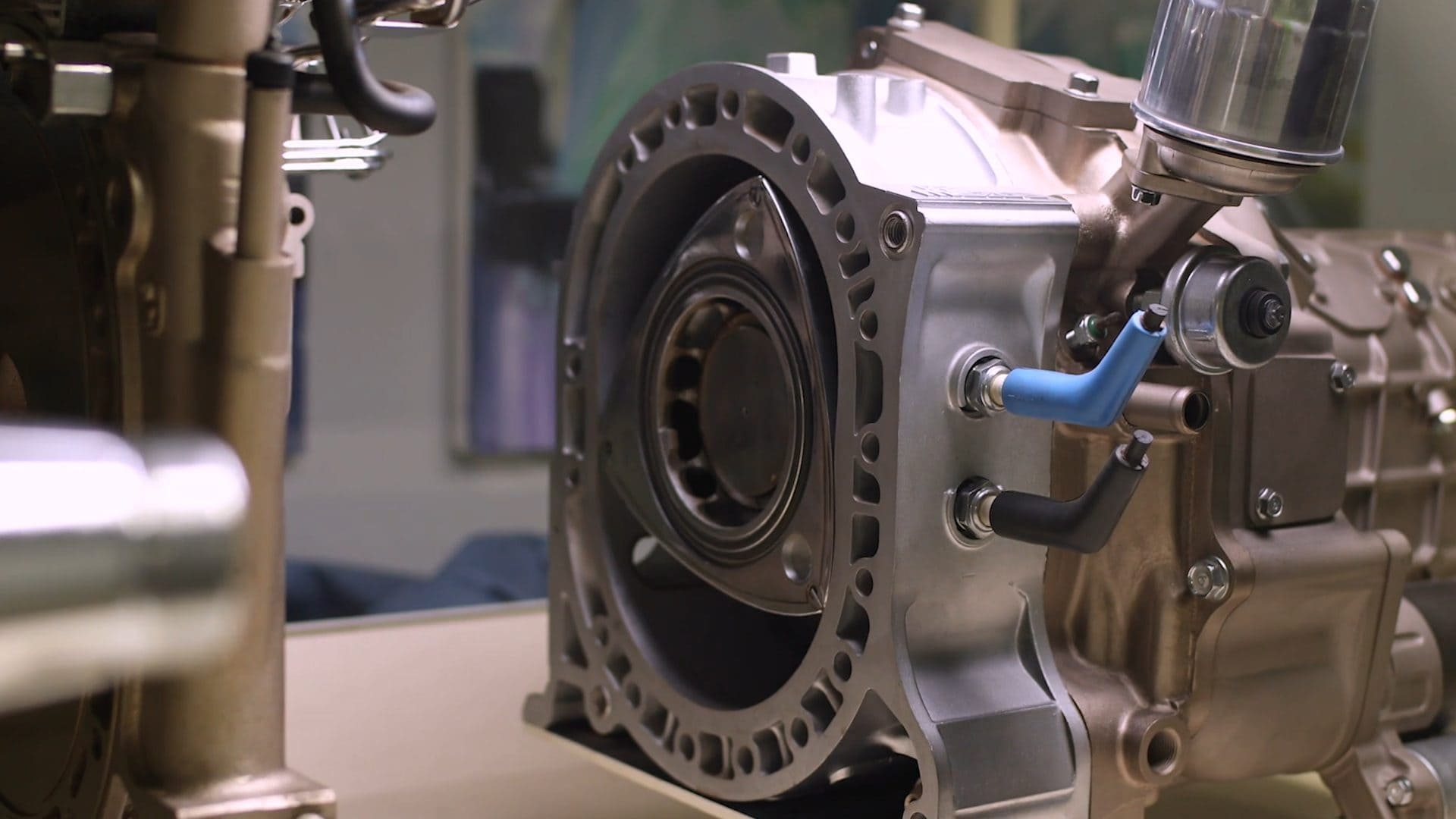
That being said, they’ve maintained a major cult following and in some aspects, they still are a good choice. People have always argued if there was as much engineering put into the rotary engine as there has been for the piston engine, maybe the rotary would be as efficient and reliable as a piston engine.
And in the same way, sure, maybe the aerospike could improve and be a more viable choice with an increase in research and development. But much like the rotary engine, would it really be worth it? Would it really ever really be better than the alternatives? You’ll hear me say this all the time, rocket science and engineering is just an insanely complex series of compromises. The art of rocket engineering is balancing alllll of your variables, not only in performance but in reliability, cost, development risk, manufacturing and tying them all together to make the right choice for your vehicle.
At the end of the day, aerospikes’ biggest advantage is being able to fire a vacuum optimized engine at sea level, but in all reality, why do you WANT to do that? Unless you are for whatever reason required to do an SSTO, you really never would need to do this because it’s much more common to just fire a sea level engine on your first stage and a vacuum optimized engine on your upper stage.
So what do you think? Do you think aerospikes are too cool to ignore? Think we’ll ever see one propel a vehicle into orbit or do you think the bell nozzle is just the right choice? Let me know your thoughts in the comments below. And be sure and let me know what other questions you have about aerospike engines, rocket engines, or rocket science in general and stick around because I have a perpetually growing list of awesome articles I’m trying to crank out.
Special thanks to Charlie Garcia for chatting with me about aerospikes for hours and hours and helping me grasp a lot of the technical points. He’s my go to personal actual rocket scientist and he has an awesome YouTube channel, definitely check it out and start learning even more in depth!
Another thanks to @MartianDays on twitter for those beautiful engine renders that were meticulously drawn to scale!
If you want to help me continue to do what I do, please consider supporting by becoming a Patreon member! Patreon members gain access to our exclusive sub-Reddit, an exclusive Discord channel, they get bonus material AND exclusive live streams!







Thanks a lot for this cool article.
Awesome research and documentary, its really really cool to see how you can explain in layman terms stuff that truly complicated…
It would be fantastic if you could do something similar in regards to orbital mechanics and orbital navigation, how a starship knows where it is when there is no GPS.
Thank you so much and keep the videos coming!
Now that would be awesome!
Awesome job Tim, thanks heaps!
Thanks Tim. It looks like you hit the research jackpot. I can see the amount of work you did on this subject and, I for one, really appreciate it. Thanks again. Alan Rogers
PS have you thought about trying to make a Kerbal aerospike engine demo? Is it even possible? Good luck with that. AR
Oh Tim, I just had another thought. I’ve seen fighter jet nozzles that opened and closed whether they were flying subsonic or supersonic. Can’t rocket engines use that principle? Ask Elon when you get a chance. Thanks again, Alan Rogers
I think that they don’t because the can not handle that mutch heat and pressure also they are very heavy
Tim thank you for all the work. I appreciate it. I think we could see an aerospike on a nuclear thermal propulsion set up.
Superb article, I learnt a huge amount quickly and easily!
Rick at Aspirespace
Yo! Been really waiting on your aerospike video to drop.
Really comprehensive stuff.
I know it’ll help out in the aerospike research I’m doing.
Cheers!
Hey Tim,
I saw your video about aerospikes and wanted to reach out to you about a possible solution to the cooling problem of the spike, to be clear I am just a sophomore in high school with no real knowledge of thermodynamics but I thought this idea was kind of interesting. I’ve been following a lot of news surrounding SpaceX’s new starship and was intrigued by the “Sweat” cooling system they had opted to use for re-entry into the Martian atmosphere – wouldn’t pursuing an aerospike that also sweats out some form of methane like liquid from tiny pores around the spike be a good option? As it would create a boundary between the spike and the hot exhaust coming from the engine by creating somewhat of a Leidenfrost effect. I understand that the task is probably way more complex than just pumping out fuel as a coolant (which presents its own set of challenges) but the idea just seemed like it might work especially since even SpaceX thinks of it as a viable cooling option for applications dealing with the same temperature ranges.
I would love to hear your thoughts on this and keep up the great videos! – they are super helpful when trying to understand a lot of the information that is more in-depth and easier to understand for the everyday astronaut.
Thanks!
So the “Sweat” Cooling also called Transpiration cooling is another type of film cooling that has been used for other engines before (Starship’s usage over such a large area is new but fundamentally it’s film cooling.). I imagine it would work for cooling and I think the RS-2200 actually uses this. But it loops back to the problem of weight and complexity. Adding the additional mechanisms for the cooling is more complex than just regenerative cooling adding more failure components and more weight.
Nice. No problem with the length of the video by the way. Towards the end you mention that if Earth’s atmosphere were denser aerospikes might be more advantageous. That suggested to me a use one day could be Venus sample return, assuming future engineers can solve a thousand other problems including that of shedding heat, but I imagine you’d use a balloon to get above the majority of the atmosphere before launching to space. Thanks for the thought-provoking article.
Ok, so a big thing that you and a lot of rocket designers are assuming when considering aerospikes is that, to have a staged rocket, you have to stage it vertically.
That’s actually a really bad assumption. Think of the Space Shuttle: all of its stages were horizontally attached, NONE of them were actually vertically attached one atop another.
To get the most out of an aerospike, you’d want something that looks a lot like the Space Shuttle did: a big, disposable fuel tank (fuel tanks are actually extremely cheap to make, and disposing of the External Fuel Tank rather than trying to reuse it was one of the smartest compromises the Shuttle made) that fuels an engine that fires all the way up to orbit.
Hi Tim,
Love your work.
Thanks for the great breakdown on the ‘underdog’ of rocket engines.. Aerospike. When the right design team gets onboard the Aerospike may truly come of age. Your effort in exposure of these potentially game changing propulsion units may just be the push needed to go forward.. or upward ?
Anyway, I have a question regarding steering the inline version. The rotary version should be capable of gimbaling to any direction of thrust for the rocket’s guidance.. however, the inline version has only a 180° thrust vectoring capability. Therefore, multiple perpendicular inline units would be needed for full steerage control. Am I missing something? Could a hybrid be developed using bell nozzles for steering and thrust and Aerospike inline versions for thrust and minimal steering?
Keep us informed Tim.
Thanks
Hi Tim
Can you provide a list of references for this article?
Thank you!
Hear! hear! I second this request for references.
I am working on a AeroSpike nozzle I wish to share with you, so you can comment on it. https://www.dropbox.com/s/rata3solv12k52l/TurboRockBurner%20Nozzle%20Ring.jpg?dl=0. Please speak your mind, I am all ears to your thoughts about it. Thank you ( ?° ?? ?°)
Based on the principles described in this very informative article, could the Draco thrusters on the Spacex Dragon capsule be considered as aerospike engines in that a lot of the thrust shaping is done out side of the nozzle?
ESA recently made funding available for an aerospike study: INVESTIGATION ON THE KEY ISSUES FOR THE REALISATION OF AN AEROSPIKE ROCKET ENGINE.
The goals: “Conceptual design and realization of an aerospike engine, by means of inter-disciplinary computational tools (virtual design) and additive layer manufacturing process (3D printer) using ceramic composite materials, to remove the classical drawback of this type of engine and demonstrate its economic feasibility.”
I still vote for nuclear thermal, though 🙂
Nuclear thermal is not useful for launch. The thrust to weight ratio is BAD. Not to mention the issue of accidents and radiation in the exhaust stream. It is great for interplanetary flight, but even for cis-Lunar you are better off using conventional chemical propulsion and refueling as necessary.
Thanks a lot – you have de-confused me quite well – only 99999 more subjects to go 😉
It seems the thrust of an Aerospike engine can be regulated in a wide range. If it’s true then this is one more an advantage of that engine for 1st stage of the rocket.
Thank you!
Thanyou EA, for your video very informative and interesting, your great. I knew that there was something maybe a conspiracy about why theyre not used. But in actual its due to complexity and cooling. I enjoy watching space rockets on youtube from other countrys like japan, china, soyus etc can you do a video comparing everyone!!! Also I would really really love to watch a video made by you on ramjets, and fission fusion drives. Or just a whole thing about nuclear powered orbital launches.
Best wishes,
Happy New year.
Hbyte
Yay, DEAN concept! Fingers are crossed for an expander-cycle article and video in the near future, maybs a “part II” for the big engine cycles article, because personally wethinks that might be where fully mature chemical rocket technology ends up, at least unless we hit an unexpected additional limit on practically regenerative cooling wattage. If it turns out to be practical, it’s definitely desirable, while chemical rocket SSTO… in addition to “can we do it?” is the question of “is it the best thing to do?”
From this viewpoint, the shiniest thing about aerospikes, at least to this reader, is that they look to plausibly be part of the key to improving available pumping wattage. That stuff about new manufacturing advances looks pretty shiny too, thanks for bringing that to our attention!
Great article and a fun read. Keep up your wonderful work!
Another really promising use of aerospikes is in air-augmented rockets: particularly if you place this Thrust system on the back of a horizontal-takeoff spaceplane, or on the launch stage of a multi-stage (2 or 3 stage) rocket.
Remember what Elon Musk said about how if you have a really difficult problem, maybe you’re asking the wrong question, basically? Well this is absolutely true of trying to cool aerospike throats/nozzles.
Aerospace Engineers have been trying to deal with the heat of a combustion chamber that heats gasses to really insane temperatures and then heats them even more as they pass through the throat of a rocket. But there’s a simpler solution: dilute those really hot combustion products with cooler gases from OUTSIDE the rocket (ambient air) and then eject THAT cooler mixture through the nozzle- at temperatures that no longer threaten to melt your nozzle.
This would seem like it would reduce exhaust velocity: and it does. But because air-augmented rockets obtain additional Working Mass- they spread the same heat out over more molecules (extra molecules which, importantly, AREN’T part of the weight of the rocket, but are in surrounding air) and obtain more Thrust for the same fuel-consumption (up to DOUBLE the Effective ISP) despite a lower exhaust velocity. Ask me for the math and physics behind this if you still don’t understand this magic (would take about a page to explain).
Air Augmented Rockets produce a lot of extra Drag from scooping the atmospheric air, and some extra plumbing to divert it into the rocket, but they are in the net a tiny bit better than normal rockets- just another one of those things that has been labeled “not worth the effort”, like Aerospikes. However when you COMBINE the two, you eliminate a lot of the problems each has- and get a system that is much better than either on its own…
Aerospikes work best at low altitudes (where pressure is initially high, but drops rapidly) as do Air Augmented Rockets. They tend to melt: but the ambient air added to the engine could really help keep them cool. Air Augmented Rockets have problems with the additional weight of the ducting: but when you add that weight to an already-heavy rocket engine like an Aerospike, and add a lot of additional Thrust from the air-augmentation with it, you could potentially end up IMPROVING the Thrust:Weight Ratio.
For example (made-up #’s), an air-augment system might double the Thrust of a typical rocket, but increase weight by 120%. However if you take an Aerospike, which already weighed 50% more than a typical rocket, but produces 20-30% more Thrust in the lower atmosphere, and make it air-augmented as well; not only do you now save a lot of mass on cooling the Aerospike engine in the lower atmosphere where Thrust is needed most (higher up, but before first stage separation, you might Throttle down to reduce heat production, or dump additional fuel into the combustion chamber of the Aerospike to run it more fuel-rich: also reducing heat production…) you also improve its Thrust even further than you did by improving nozzle efficiency.
And, what increased the mass of an X ton conventional rocket by 120%, would only increase the mass of a 1.5X ton Aerospike by 80%. But you still improve its raw Thrust 2-fold (increases to Thrust from higher Working Mass are completely seperate from those from higher nozzle efficiency, and multiplicative with it if you still obtain the same chamber pressure: so Thrust is now 250% that of a comparable conventional rocket instead of 125 or 200%, as 1.25 × 2 = 2.5!) and so your Thrust:Weight ratio actually IMPROVES.
In short, Air-Augmentation and Aerospikes are complementary not only with heat-management but with TWR, because one increases the Working Mass (air aug) and the other increases how EFFICIENTLY you use your Working Mass, and is blind to the source of that Working Mass (Aerospike). And, of course, I must reiterate, you lower your exhaust temperature (without lowering chamber pressure) by injecting additional air from outside the rocket, which while very hot from being ram-compressed to very high pressures, is still MUCH cooler than the normal exhaust gases of an aerospike. Thus, the superheated air acts to help cool the aerospike nozzle.
For an even more advanced design: one which also acts as a ramjet and scramjet in the atmosphere, then converts to a pure rocket, look up Rocket Based Combined Cycle engines. For an overview of RBCC, I recommend the 2010 Master’s Thesis of NJ Williams from the University of Tennessee: which is publicly available online.
As I mentioned before, you can also place Aerospikes on a horizontal-takeoff spaceplane, and air-augmemt them as I just described. This is PARTICULARLY powerful, because spaceplanes can reach orbit with a total vehicle liftoff Thrust:Weight Ratio of considerably less than 1- they use Lift to ascend in the lower atmosphere (meaning they to have to produce a fraction of their weight in Thrust to hold themselves up: for instance at a Lift:Drag ratio of 5, a spaceplane with a TWR of just 0.2 can maintain level flight- and as end with any more than this!) level out for speed, and can potentially fly a lifting-ascent until their speed is high enough that the curve of their ballistic trajectory starts to become small enough to reach orbit with a TWR less than 1…
There are a variety of Air-Augmented rocket designs in existence, which makes this confusing: but it appears at least SOME of them use designs that could be combined with an Aerospike Nozzle.
Air-Augmentation (aka. “Ejector Rockets” or “Ducted Rockets”) currently only works up until about Mach 3-4: so this would be a thing only for launch stages. But it definitely has the potential to make the heating-issues of Aerospikes more manageable in the Mach 0-4 speed range: which represents quite a bit of the fuel-consumption in a rocket ascent (a typical launch stage expends over half its fuel-weight within the first minute…) The weight saved on fuel with a Ejector+Aerospike rocket configuration could more than make up for the added weight of the engines, if I’m not mistaken (higher engine ISP generally justifies somewhat higher engine mass, due to the way the Rocket Equation works…)
Hello, Tim. First, I would like to say that I watched your excellent video on Youtube about aerospikes – “Are aerospikes better than bell nozzles?”
It is of very high quality and I thought you approached the subject with perfect depth. However, I would like to suggest that if you are going to make any updates to that video, reconsider the notion that the usefulness of aerospikes is limited basically to SSTO vehicles. IMHO, this fetish about SSTO is what compromises the idea of aerospikes. I always liked those engines because you could use them to accelerate and brake a rocket. To illustrate how this fetish can blind us to certain opportunities, consider the following: a two-stage rocket, the first with an engine optimized for sea level, with a traditional nozzle. In the second stage, an aerospike. Nonsense, everyone would say, just use a vacuum optimized nozzle. And I would agree if my intention is not to return. However, Elon insists to recover every piece of his rockets and so the second stage MUST return. One of the disadvantages of aerospike engines is the extra weight from the spike, but in a reentry, this could be advantageous. Yes, thermal management is the greatest challenge for aerospikes – but once you solve that, you can capitalize on such a solution in a reentry profile.
It wouldn’t be “wrong” to say that a truncated spike can be seen as a blunt reentry vehicle, not far from the profile used in the nose cones of ballistic missiles from the 50s (you would need to balance the ratio between the area of the spike with the diameter of the rocket). Second stages are usually short and with an aerospike, the center of mass would be far closer to the bottom, as any residual mass would mostly be there (the heavy spike, the engines, the remaining fuel/propellant) and closer to the heat shield (the spike) and the center of drag. That way I think you could manage the reentry profile quite well in terms of its aerodynamic aspects. And since you tackled the thermal management problem to make your engine work, it’s time to use the same hardware to face the thermal challenge of a reentry. There are other advantages. Any engine optimized for operation under vacuum has a very long bell nozzle, something that would require very long (and heavy) legs for a landing. Probably you would need to retract the nozzle into the tank structure. Almost every single two-stage rocket has just one or two engines in the second stage. The Falcon 9 goes from 9 engines in the first stage to a single one in the second stage. Throttling the propulsion for a landing is easier and more reliable when you have multiple engines.
It would be a challenge to do this with just one engine. The aerospike, on the other hand, is by definition shorter than an equivalent bell nozzle, so no need for longer legs to land or hardware to retract it. And since you have several small engines around the spike, you can solve the engine throttling problem by controlling the output of each engine/chamber. This would also grant you a certain degree of steering performance in the reentry and the approach to landing, in a much more delicate way than you could achieve with a single big engine (if the spike is mounted on gimbals, this can play a role during this phase too). There are other small details, like using the heat of reentry to drive a small turbine/motor to feed flight control surfaces (perhaps you wouldn’t need cold gas thrusters) or use propellant to manage the shock layer, but that’s not relevant in the grand scheme of things. I was surprised to learn that Elon Musk considered using aerospike engines, so I presume SpaceX did a CFD analysis and found some insurmountable flaws in this concept that I’m describing. Anyway, I agree with you, aerospikes are cool, it just happens that I believe they are more than that. And forgive me for any mistakes in writing, English is not my first language.
If you have the opportunity, ask Elon Musk, please, if SpaceX analyzed the use of aerospikes engines during the entire flight envelope, especially regarding the viability of using the spike from the engine as the heat shield and then approaching reentry like a blunt body. In your video, Elon said that if there was a way to make a design better, that would be a gift. My previous considerations are related to an eventual approach that would allow recovering Falcon 9’s second stage, however, I noticed today that in Starship they opted for a mix of engines for sea level and vacuum. If an aerospike engine could be used as I´ve described, such a mix would not be necessary. In fact, it would be one less change to be made on the Starship version intended to land on the Moon. And I sincerely believe Starship would benefit from such approach, because it’s not exactly cylindrical and if they remove the tail fins, use the small surfaces in the front as canards and execute a reentry on Mars tail/spike first, like a blunt body, they could have a more controllable flight on Mars using engine throttling, the RCS and the canards than the current approach they publicized.
These benefits would be even greater if SPACEX really intends to use Starship for point-to-point flights on Earth. All of these possible benefits, of course, would be in addition to the indisputable advantages of an aerospike for the first stage. Maybe I’m just an imbecile who can’t see a fundamental flaw in what I’m proposing, but it looks like a promising approach.
“ But while sitting there chatting with Peter, it got me realizing that the Electron uses 9 engines, and I wondered if they could do anything like gimbaling inwards to utilize some unique aerospike like effects… here’s his response…
“Oh there’s stuff you can do”
Interesting… Maybe there’s actually something to that!”
You’d have the same opportunities with the Falcon 9, but more interesting is what happens with the inner and intermediate rings of engines on a 31 engine SuperHeavy.
Does the center engine on a Falcon 9 perform better than the outer engines? It’s plume is fully surrounded by other plumes traveling at the same speed, so it should always be at pressure equilibrium. That should also be the case for at least 13 of the 31 engines on a SuperHeavy.
Awesome 🙂
Could you have possibly found a font color that is even harder to read?
Hello excellent video … Engineering is the art of the possible … that’s what we say here in Brazil.
I believe that a possible variation could be used in the Falcom9, imagine the central engine a little back in relation to the other engines on the outside.
When entering a low atmosphere environment,
outboard engines could convert their jets towards the center.
Imagine that the central engine would generate the necessary pressure to form a virtual cone or a geometry similar to that which would be needed to form a compression of the jets and thus a way to more efficiently direct the jets.
Note that as the 9 engines are aligned and all in the same direction, the gases will expand laterally out of maximum efficiency, but if these jets were directed to the center, they may generate better efficiency.
Torodially aero-spike uses multi-combustion chambers. To simplify it, I have designed 3D model, with externally and internally film cooling and fuel injection that way, that flame do not touch walls. four segment fuel injection might eliminate gamble, using asymmetric fuel flow. The further the stream goes down of the spike, the lower the temperature, like the nozzle version. Using CAD, FEA, CFD super-sonic and thermal analysis help me to understand what I do.